

STANDARDPRESS
CALL FOR CHANGE
Lapiscians urge senatorial candidates to prioritize education reforms
orty percent of students from Las Piñas City National Science High School (LPSci) support the prioritization of projects aimed at improving the education sector in the Philippines, which they hope will be implemented by the winning senators of the 2025 midterm election, a recent survey has shown.
The students, ranging from Grades 10 to 12, cited the need for thorough planning, modifying the curriculum to make it more holistic, increasing funding for teacher training, improving facilities and learning tools, and including contemporary issue-
based programs in the sector.
Changes in other sectors the students advocate for include budget transparency, accountability for corruption and project execution, investment in climate action, increased funding for healthcare and agriculture, improved public transportation and government processes, and stronger animal welfare policies.
Desired changes
“Want ko sana ng senator na kayang mag-push ng comprehensive curriculum that includes not only kung gaano ka-competitive ang [Philippines] with other countries but also takes students’ welfare into consideration (I want a senator who can push for a curriculum that also includes the
students’ welfare),” Ava Lim of 12Diplomacy said.
Lim said she wants a more “holistic” education curriculum that can be pushed for Filipino students by a potential winning senator.
“We really need a senator who can be a voice for those beings who are voiceless,” Jaina Pascual, a student from 10 - Fortitude, said.
Pascual said animal cruelty has been recently prevalent in the Philippines, citing the country’s need for a senator who can implement laws to end the suffering of animals.
According to the Philippine Animal Welfare Society, animal cruelty cases in the country have an estimated 95-98% conviction rate.
Senatorial bets
Former senator Kiko Pangilinan, advocating for the agriculture sector, is the leading senatorial bet of LPSci’s registered student-voters.
Other senatorial candidates favored by the students include Bam Aquino for education, Heidi Mendoza for procurement reform, and Luke Espiritu Jr. for workers’ rights.
“I have trust in these candidates to know the correct approach, values, principles that favor sustainable solutions to any situation,” Lance Saludo, a studentvoter from 12 - Generosity, said.
continue on page 03








Sara Duterte becomes first VP impeached by House
Sara Duterte became the first Vice President in Philippine history impeached by the House of Representatives, reaching a total of 215 signatories — surpassing the 102 out of 306 requirement — on the last day before Congress adjourned ahead of the midterm elections.
Of the four impeachment complaints filed against the Vice President, the fourth served as the lead complaint, while the rest were archived.
According to 4Ps Party-list Representative Marcelino Libanan, the first three impeachment complaints were endorsed by the minority but the fourth was necessary to consolidate all charges into one for stronger support from the lower chamber.
The grounds for Duterte’s impeachment included the misuse of confidential funds of the Office of the Vice President (OVP) and Department of Education (DepEd), failure to disclose all her properties in her Statement of Assets and Net Worth (SALN), and contracting an assassinator for President Ferdinand Marcos Jr., First Lady Liza Araneta Marcos, and House Speaker Martin Romualdez. Romualdez, who was the 215th signatory, has directed Secretary General Reginald Velasco to transmit the complaint to the Senate for trial.
The Speaker praised the House in his remarks before adjourning the session, saying nobody is immune from the will of the people.
“This Congress will not allow itself to be used for any interest, except for the interest of the people. We will fight for what is right. We will right the wrong,” he expressed.
The Senate, however, adjourned sessions on Feb. 5 until June 2 without discussing the impeachment.
Senate President Francis “Chiz” Escudero said in a speech Feb. 8 that the upper chamber will finish the process without rushing the proceedings.
Sixteen out of 24 votes from the Senate are required to convict and oust Duterte from office.


By LANCE KIANE G. SALUDO
By QIANNE YAHJ D. ENRIQUEZ
By DANETTE RAMIEL S. ELIAS
Art by JAMEELA L. CABORDA

6-in-10 Grade 7 students opt for revision of MATATAG curriculum
bout 60% of Grade 7
Astudents from Las Piñas City National Science High School (LPSci) want to have the MATATAG Curriculum revised, a recent school survey says.
Majority of the students who want to experience a change in the time allocation for each subject to lessen school work and academic pressure.
“The subjects and topics given for each quarter are much too excessive for the timespan and student’s learning capacity,” Louise Arpon, a student from 7-Blessedness said.
Arpon said the “information overload” results in the students’ stress and anxiety, suggesting such a “sudden” change should be done “little by little.”
“Due to the cramming of schoolwork and lessons in order to fit into the new schedule, I haven’t been able to properly learn or understand my subjects,” Castiel Go from 7-Accountability, said.
Go said the “cramped” schedule of learning and activities is like being “given food but rushed to the point that they can’t even chew.”
The newly implemented MATATAG Curriculum follows a 10-subject-per-day schedule for science high schools where 45 minutes are allotted for core subjects and 30 minutes for electives.
INVESTING IN WELLBEING
New law inked to expand mental health programs in schools
8-CONNECTION, S.Y. 2023-2024
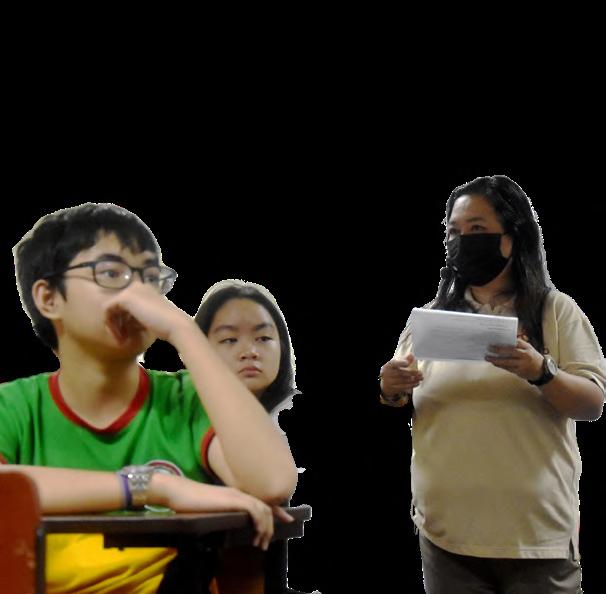
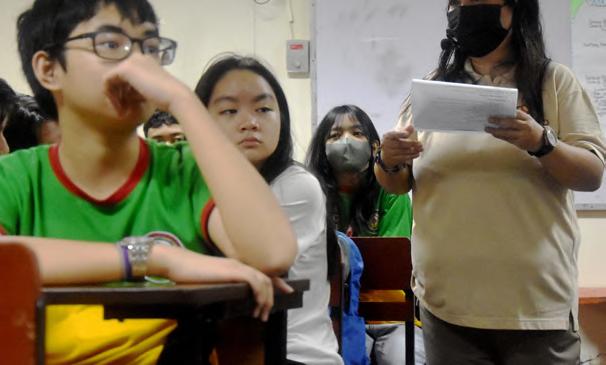
Half of Grade 12
students chose courses at most 1 month before UPCAT – survey
Forty-nine percent of Grade 12 Lapiscians only decided on their college course at the earliest, a month before the University of the Philippines College Admission Test (UPCAT) application deadline, according to a survey by The LPSci Standard Press.
In a survey of 47 respondents, 17 (36.2%) reported they only decided on their dream course a month before the application deadline, while six (12.8%) said they had changed their dream course after the application period.
Asked which factor they would consider if given additional time, 14 (29.8%) mentioned personal interests and passion, 13 (27.7%) mentioned financial practicality, and nine (19.1%) mentioned accessibility of jobs.
Of all respondents, 17 (36.2%) answered “no” when asked if they felt that they had given enough thought to their selected courses.
The UPCAT 2025 application period for the current Grade 12 batch ran from April 15 to May 31, 2024.
In a related poll for Grade 11 students, 44 of 57 (77.2%) respondents said they are already decided on their college course.
For current Grade 11 students, the UPCAT 2026 application period is scheduled for March 3 to 31, 2025.

resident Ferdinand Marcos Jr. signed into law Republic Act 12080 or the Basic Education Mental Health and Wellbeing Promotion Act on December 9.
The law mandates the establishment of Care Centers in public and private schools as well as the presence of Mental Health and Wellbeing Offices in Schools Division Offices (SDOs).
School Care Centers shall be responsible for developing a localized mental health program, strengthening existing programs, conducting mental health monitoring for learners, and providing mental health-related referrals to teaching and non-teaching personnel.
The law defined the localized mental health program as one that promotes the management of mental health concerns of all learners, citing the prevention of suicide in schools as its distinct example.
Meanwhile, SDO Mental Health and Wellbeing Offices shall provide a general framework for the school-based care center programs under its jurisdiction.
Marcos spoke of the law as also an investment in intellectual, emotional, and social development.
“When our learners and school personnel are mentally healthy, academic

performance improves, absenteeism decreases, and a culture of compassion and understanding flourishes,” Marcos said.
“This law aims to bridge that gap by embedding mental health services directly into our schools—our nation’s first line of defense against mental health issues,” he added.
Additional plantilla positions School Counselor, School Counselor Associate, and Schools Division Counselor will be implemented, whose job candidates’ eligibility shall be screened by the Department of Education (DepEd), Department of Budget Management (DBM), and Civil Service Commission (CSC).
The DepEd, DBM, CSC, and Professional Regulation Commission (PRC) shall also be responsible for the preparation of a uniform career and personnel development plan for the new positions, including provisions on the personal wellness, merit promotion, performance evaluation, and in-service training.
School Counselors and Schools Division Counselors must be either a Registered Guidance Counselor or a Registered Psychologist, while School Counselor Associates shall be college graduates who have taken at least 18 course units in Guidance Counseling or Psychology, or 18 units in Behavioral Science with 200 hours of internship in Guidance Counseling.
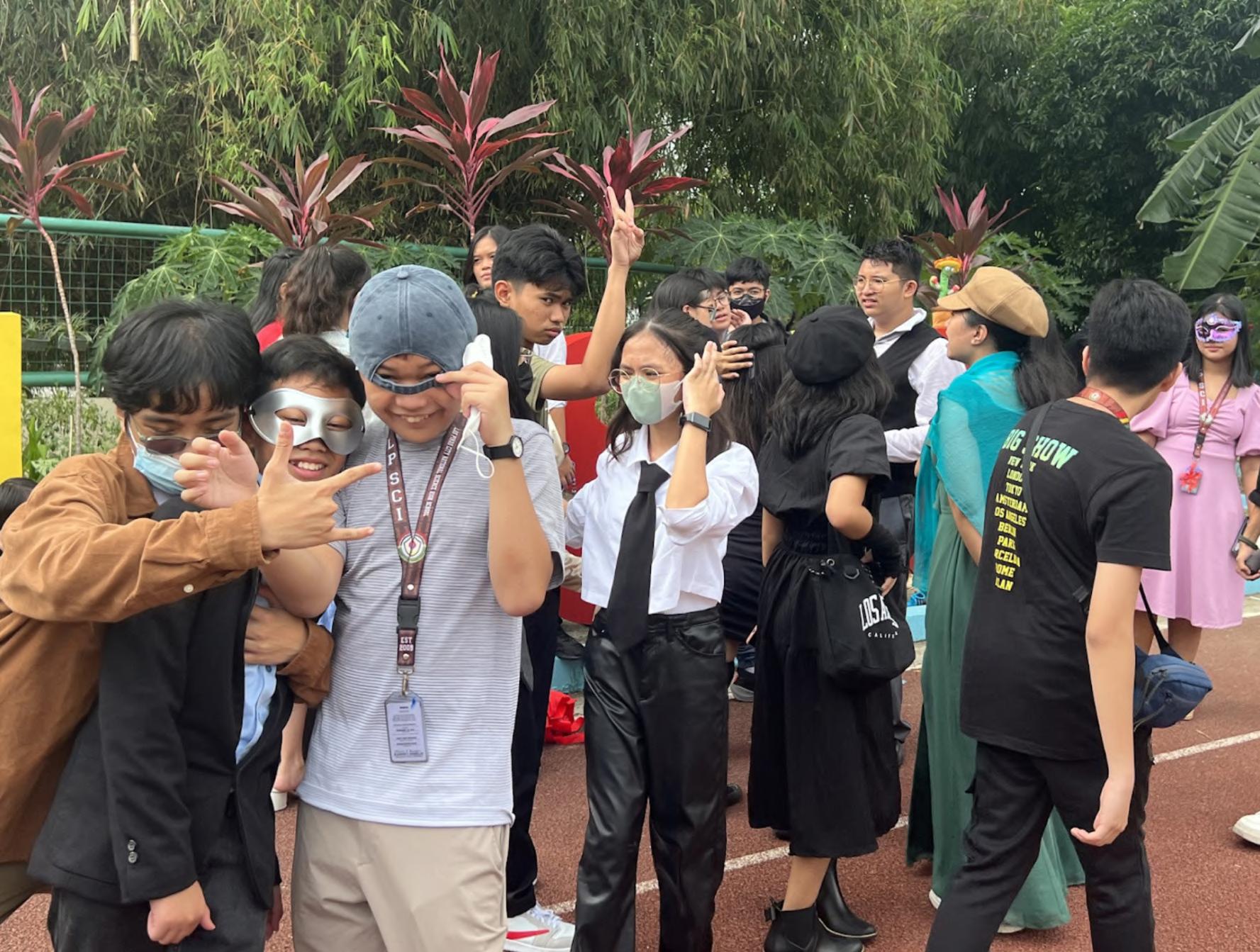
Health caravan brings free services to 600 residents of Talon Dos
Cousins April Aguilar-Nery and Carlo Aguilar are set to compete for Las Piñas City mayor in the 2025 midterm elections, highlighting a clash between the incumbent Aguilar administration and the rivaling Villar camp.
April is running after a two-term stretch as the city’s vice mayor to her mother, Mayor Imelda Aguilar, who is now running for vice mayor.
April’s father, former mayor Vergel Aguilar, is an elder brother of Senator Cynthia Villar.
Meanwhile, Carlo is running after four terms as the city’s second district councilor along with aspiring vice mayor and fellow second district councilor Luis Bustamante.
Carlo is the son of Christian Aguilar, who is also an elder brother of Cynthia.

Carlo and Luis will be running under the




Nacionalista Party (NP) with Cynthia running for the lone congressional seat of the city. Cynthia is running against Mark Anthony Santos, who campaigned for both Villar and Aguilar camps during the 2022 elections.
Santos – now running with the Aguilar camp – disclosed that the Aguilars and their allies will not endorse or campaign anybody from the Villar camp, including aspiring senator Camille Villar.
“For the past three decades, the Villars and Aguilars are together in one political umbrella. But now, no more because of Mrs. Villar’s selfish political agenda,” Santos stated.
Santos said he remains undeterred despite running against the wealthiest politician in the country.
Cynthia is likewise undeterred, confident in her accomplishments being the key for providing the needs of Las Piñeros.
“I can do a lot for Las Piñas. I am very experienced. I know what to do, and I’ve been here for a long time,




so I know what Las Piñas needs. To emphasize what I have accomplished for Las Piñas, the people will judge if they are satisfied with my accomplishments,” Cynthia said.
Santos previously served as chief of staff of Cynthia’s elder brother Vergel. Also vying for the city’s lone congressional seat, Attorney Louie Redoble is once again aiming to end the Aguilar and Villar political dynasties.
“Walang pantay na oportunidad sa ating mga Pilipino. Kung ikaw, kontrolado mo ang politika sa isang probinsya, isang siyudad; lahat ng negosyo diyan ay kontrolado mo rin. Pangalawa, walang kompetisyon na mangyayari. Kung walang kompetisyon, hindi po lalabas ang galing ng tao,” Redoble said.
Redoble ranked second to Camille for the position in the 2022 elections, garnering half the amount of her votes.




2016-08).
By DANETTE RAMIEL S. ELIAS
To offer accessible and free health services to more Las Piñeros, the local government of Las Piñas City stretched its Health and Wellness Caravan to Barangay Talon Dos, headed by Vice Mayor April Aguilar, January 21.
The Health and Wellness Caravan was open to everyone, encouraging nearly 600 residents to avail the free services included in the Health and Wellness Caravan including medical consultations, electrocardiogram tests, pneumonia vaccination for senior citizens, and others.
“‘Pag [nagkaroon kami ng] health caravan, it makes us closer to the people para ma-serve namin sila (Having a health caravan makes us closer to serving the people),” Vice Mayor April Aguilar said.
April said the caravan brings the services closer to the residents who are “sometimes discouraged” from going to health centers.
“Andito na [sa caravan] lahat ng equipments namin so lahat magagawa na sa kanila sa isang upuan (All of the city’s equipments are available in the caravan so all services can be done for the residents in one sitting),” she said.
The vice mayor said all services in the free medication station are complete to the point that it looks like a “Mercury Drugstore.
“Malaking tulong kasi gaya [nito] na ‘di tayo maka-afford (It is a big help for us who can’t afford it),” Genelyn Calibut, a resident who availed the free check-up and medication, said.
Calibut said the Health and Wellness Caravan offered a big help for residents who are sick and cannot afford check-ups and medicine.
The caravan is set to go to Barangay Manuyo Dos on January 28.
The WRF is funded through a partnership with the Japan International Cooperation Agency (JICA) and the Development Bank of the Philippines (DBP).
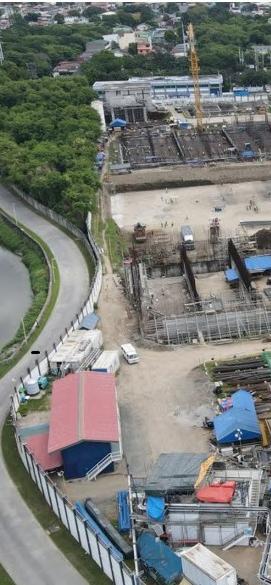
CHERISHING PRECIOUS BONDS. Classmates Anthony Dumanglas (Left), Elijah Discipulo (Middle), and Ian Panahon (Right) feel their Christmas Party OOTDs as their section scrambles for a class photo on December 2023. Photo retrieved from
MORE TO COME. Students from 7-Bravery tune into their second of 10 subject periods on February 7, 2025 under the MATATAG curriculum. Photo by JOSE YNIGO U. PANGILINAN
By QIANNE YAHJ D. ENRIQUEZ
localnews.
By LANCE KIANE G. SALUDO
By LANCE KIANE G. SALUDO
By DANETTE RAMIEL S. ELIAS
schoolnews. schoolnews.
By LANCE KIANE G. SALUDO localnews.
tracingthefamilytree.
CYNTHIA AGUILAR-VILLAR Running for LP Congresswoman (Senator, 2013-2025)
IMELDA AGUILAR
APRIL AGUILAR-NERY Running for Las Piñas Mayor (Vice Mayor, 2019-2025)
CHRISTIAN AGUILAR
MARK VILLAR Incumbent Senator CAMILLE VILLAR Aspiring Senator
MANUEL VILLAR VERGEL AGUILAR
CARLO AGUILAR Running for Las Piñas Mayor
BLOODY RIVALRY. Carlo Aguilar, nephew of Cynthia Villar, vows to improve the lives of residents as he challenges cousin and two-term vice mayor April Aguilar-Nery in pursuit of mayoral post on October 7, 2024. Photos from SMNI News & Vice Mayor April Aguilar/FB
Saludo said his senatorial lineup is grounded in experience and critical thinking, making them “brave” representatives of accountability for all branches of government.
“These aspiring senators are the most qualified in implementing policies and changes that adheres to the actual needs of the public,” another studentvoter, Jose Orillaza of 12 - Efficiency, said.
Orillaza said candidates included in his lineup are labor leaders who will uphold the rights of proper employment and improve the system in both labor and education sectors.
“With them having the correct experience, they can make changes for the country,” Majelli Teodoro of 12Honesty said.
Teodoro said her senatorial bets are focused on serious matters which can prompt changes for the betterment of the country.
2025 midterm elections
The 2025 midterm elections are scheduled for May 12, with LPSci as one of the voting venues.
Sixty-eight million registered voters are expected to vote for 12 out of 66 running senators.
The dozen senators to be elected in the midterm polls will hold office for six years.


Santillan siblings sweep int’l climate video contest
In a remarkable start to 2025, siblings from Las Piñas City National Science High School (LPSci) Elijah (10-Environmentalist) and Ellesha Santillan (12-Honesty) topped 209 other entries in the Egypt-based Green Aura Voices for the Planet Competition.
Announced January 1, the contest body declared the siblings as the sole winners with their threeminute video entry “Solastalgia”.
“It was very fulfilling, as it signified not just a new year, but also a new life, that there was already assurance and opportunity waiting,” Elijah expressed in an exclusive interview with his sister and The LPSci Standard Press.
As both brother and sister starred in the video, Elijah outlined the script while Ellesha served as editor.
Describing their production process, Ellesha shared the close proximity of the environmental malpractice they highlighted in the video.
“One week [was the duration of the whole production]. Naghanap lang kami ng random spot na maraming basura, and we didn’t take that long to find it. Sa Parañaque siya. Nakakalungkot, actually, maraming nakatira sa area na ‘yon tapos nasanay na sila na ganoon ang paligid nila,” Ellesha said.
Elijah expounded on the call for action of the video essay, emphasizing the necessity of collective small steps against climate change.
“If we keep doing our cycle of pride, we’ll keep going back to our old ways that harm the environment. If no one is changing, tayo dapat ‘yung maging first step,” the brother said.



PUSHED NEXT DECADE

The construction of the Las Piñas, Zapote, and Niog stations for the Light Rail Transit-1 (LRT1) Cavite Extension is yet to start until 2026 due to right-of-way (ROW) issues with the C-5-Quirino flyover built by the Department of Public Works and Highways (DPWH) in Las Piñas City, the Department of Transportation (DOTr) said.
Due to the constructed flyover, DOTr Secretary Jaime Bautista said that the original plan for the 3.2km second leg of the project – covering the Las Piñas and Zapote stations – needs to be redesigned.
“We already have an existing alignment, but the DPWH constructed a flyover in the area and because of that, we need to redesign the project,” Bautista said.
The P300 million DPWH flyover project commenced in September 2020, under former secretary Mark Villar, and formally opened on April 24, 2024. The flyover now allows motorists along the C-5 extension to bypass Tramo and Diego Cera Avenue intersections.
Transportation Undersecretary for Railways Jeremy Regino said in an interview that they’re hoping for the new alignment to be finalized by the first quarter of 2025.
“We hope to finalize the alignment of the Cavite extension, particularly in Las Piñas, by the first quarter — either in February or March. We will address all
ROW concerns this year, especially in Las Piñas due to its realignment,” Regino told Daily Tribune.
Regino estimated that it would take the whole of 2025 to acquire the rest of the properties, leaving 2026 as the earliest time for LRMC to start construction of the railway.
The DOTr submitted a P1.45 billion request with the Department of Budget and Management (DBM) for ROW processing.
Light Rail Manila Corporation (LRMC) General Manager Enrico Benipayo said in June 2024 that the company hopes for the said stations to be completed by 2031.
“Based on our experience, in terms of length of construction and the preactivities prior to construction such as financial closure and then, of course, all the other prerequisites prior to construction. So we hope that by 2031, those [Legs Two and Three] will be on the table,” Benipayo said.
The 6.2km first leg of the LRT-1 Cavite Extension opened on November 15, 2024, connecting the existing railway to Redemptorist-Aseana, MIA Road, Parañaque Integrated Terminal Exchange, Ninoy Aquino Avenue, and Dr. Santos Avenue along the C-5 extension.
LRMC initiated its physical construction in September 2019, but suffered more than two years of delay
Funding DepEd ‘top gov’t
“We have to show them that education is the priority.”
President Bongbong Marcos Jr. reassured the public Friday that allocating additional funding to support the Philippine education sector remains one of the government’s “top priorities” amid the Department of Education (DepEd)’s P11 billion budget cut for fiscal year 2025.
“We are still talking about it and we are trying to find a way and I think we’ll still be able to do something. We are working on that item because it is very necessary,” Marcos said.
From a proposed budget of P748
billion, Congress cut P11 billion, approving only P737 billion for DepEd’s daily operations.
Digitization on hold
“Infrastructure is important, but so is investing in our people and human capital. The digital divide will widen,” DepEd Secretary Sonny Angara said in an earlier congressional hearing regarding the agency’s share in the 2025 General Appropriations Act (GAA).
Angara expressed his dismay over the reduction of “crucial” operational expenses for the computerization program the funds could’ve developed the acquisition of digital educational materials in public schools nationwide.
This comes after Congress questioned DepEd’s expenditure after exposing billions of the agency’s unspent funding, especially with regards to the DepEd Computerization Program, set to digitize education assets nationwide.
Aside from the resistance of the DepEd camp, numerous teachers’ groups
from its 2022 target completion due to the pandemic.
In April 2023, the Light Rail Transit Authority (LRTA) said only five percent of the land for the second and third leg of the project remained unpurchased, not specifying where the land was. The authority added that construction for the remaining three stations would also immediately start once the first five stations have opened.
Four months later, former senator Manuel Villar claimed that he attempted to acquire the rights for the remaining segments of the railway project from LRMC via the groups of Ayala Corporation and Manny Pangilinan, mentioning he would add seven more stations extending until Governor’s Drive in Dasmariñas, Cavite.
“A lot of investors want to get into railways but they’re worried nothing will happen to the project because they don’t have right-of-way. I can do the right-ofway because I own the land,” said Villar, as Vista Land & Lifescapes Inc. also launched the 10-kilometer, 10-lane Villar Avenue connecting Las Piñas City to Bacoor and Dasmariñas.
The LRT-1 Cavite Extension has reduced travel time from Baclaran to Dr. Santos from 55 to 15 minutes. Once finished, a 25-minute ride from Baclaran to Bacoor and vice versa shall be feasible, replacing 90-minute commutes via the road.
have criticized the large reductions in DepEd’s budget, echoing Sec. Angara’s sentiments.
“While ‘yung gobyerno natin nagsasabi na kailangan itong digitization, computerization program sa kabuuang sistema. Ang problema, hindi naman ito nagma-manifest pagdating doon sa budget,” Benjo Basas, chairperson of Teachers’ Dignity Coalition said.
Meanwhile, Angara remains hopeful that the agency’s budget will be restored after personal assurance from the President.
Construction fund, others slashed from nat’l budget
Essential DepEd programs also set to be reduced in fiscal year 2025 include the Basic Education Facilities Fund, intended for the construction and maintenance of new public schools, and the creation of new teaching positions to remedy the country’s lack of instructors.
DepEd expressed its concern that the budget cut may worsen the country’s
Las Piñas exec urges Comelec to intensify Kontrabigay efforts
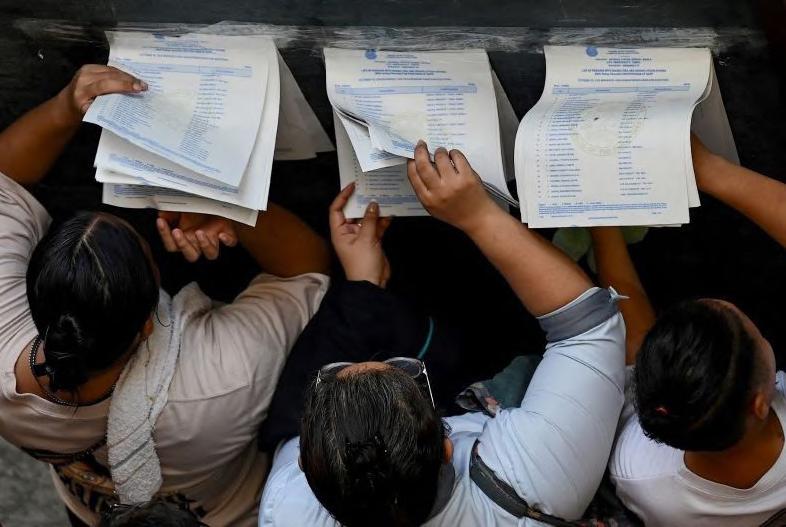
Las Piñas City Councilor Mark Anthony Santos wants the Commission on Elections (Comelec) to intensify the Kontra-bigay efforts against votebuying before the 2025 elections.
In addition, the councilor also requested Comelec to create a “Kontra-Bigay Complaint Center” so voters can report cases of vote buying in their localities.
“Ang problema sa vote buying and vote selling ay isa itong cancer sa ating demokrasya,” Santos said.
This comes after he claimed that a barangay in Metro Manila offered a minimum of P10,000 for a “straight vote” or a vote for all members of a specific electoral slate.
Meanwhile, Comelec Chairman George Garcia reassured the public that it would closely coordinate with the Bangko Sentral ng Pilipinas (BSP) and the Anti-Money Laundering Commission (AMLC).
“We have a close coordination with different platforms, the BSP and the Anti-Money Laundering Council. The Committee on Kontra Bigay leads our campaign against vote buying in whatever form,” Garcia said.
The Cybercrime Investigation and Coordinating Center (CICC) similarly warned voters to refrain from accepting cash in exchange for their votes amid the rise of unregistered e-money platforms, allowing scammers to hijack online wallet accounts.
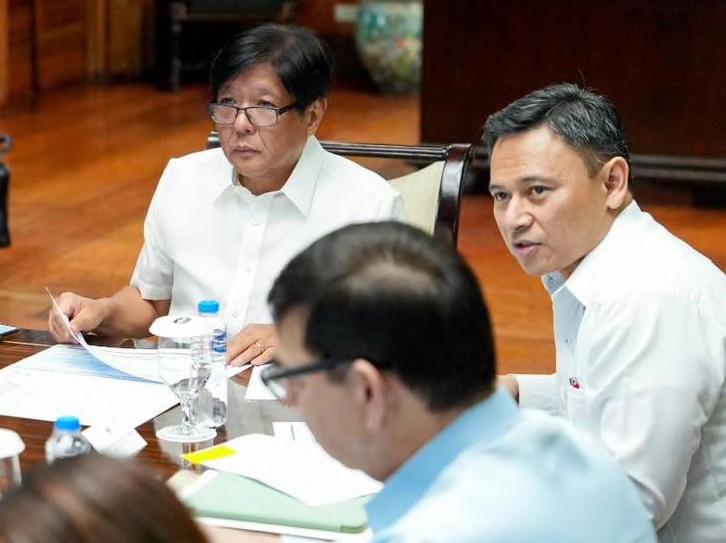
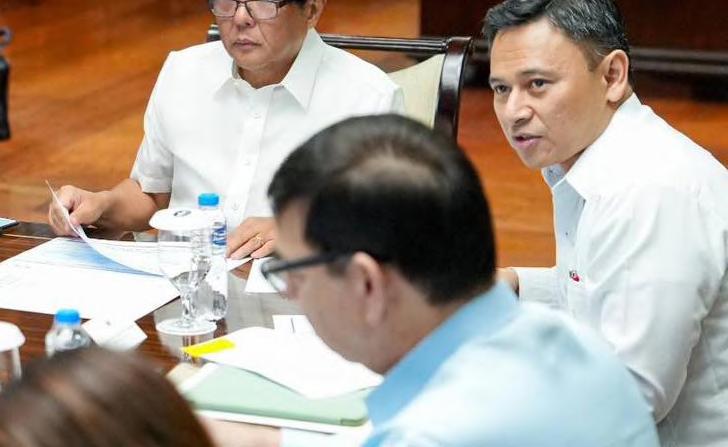
ongoing shortage of teachers among inflating other educational issues within the country.
The 1987 Constitution stipulates that the education sector shall receive the highest budgetary priority of the nation in the creation of the annual budget and that the State shall continue to provide for its advancement.
ONLY ONE PLANET. Siblings Elijah and Ellesha Santillan advocate for climate action towards achieving the 17 sustainable development goals in their winning entry for the “Voices for the Planet” competition. Photo retrieved from GREEN AURA
By SANTINO MIGUEL A. SANTOS
By LANCE KIANE G. SALUDO
By SANTINO MIGUEL A. SANTOS
localnews.

By
DSeveral Chinese illegal mining sites raise concerns
epartment of Environment and Natural Resources (DENR)
Secretary Ma. Antonia Yulo-Loyzaga expressed concern over the involvement of foreigners in illegal mining activities after confirming Oct. 17 that 11 Chinese workers carrying tourist visas were arrested in Camarines Norte.
The Chinese operations also violated the Clean Water Act for open pit mining and their Environmental Compliance Certificate (ECC) for unpermitted expansion.
“This operation has a history … However, now, they have been found to have been operating [open pit mining] also beyond the area where they have been permitted to operate,” Yulo-Loyzaga said in a Malacañang press briefing.
HIDDEN OPS
The secretary added that it is in “close cooperation” with the Department of National Defense about the recurring incidents.
On August 8, 10 Chinese nationals and one Taiwanese operating in Zamboanga del Norte were also arrested for open pit mining while operating without an ECC.
“Iba diyan [sa Zamboanga] nakabili na ng bukid, bundok,
Small-scale POGOs defy nationwide ban amid crackdown
Around 80% of the 400 hubs have shut down following President Ferdinand Marcos Jr. ‘s nationwide ban on Philippine Offshore Gaming Operators (POGOs) but many operators have shifted to small-scale, “guerilla” operations to evade the crackdown.
Presidential Anti-Organized Crime Commission (PAOCC) Executive Director
Undersecretary Gilbert Cruz affirmed on January 14 during the Bagong Pilipinas Ngayon program that authorities are closely monitoring these covert activities, particularly in Northern Luzon,
“Siguro 80 percent ng 400 na ‘yun talagang tumigil… Pero ang pagtigil natin hindi ibig sabihin na tumigil sila totally, ‘yun nga ang hinahabol natin, mga small scale (Maybe 80 percent of those 400 actually stopped... But stopping doesn’t necessarily mean they stopped completely. That’s what we’re aiming for—the small scale ones),” he said.
According to Cruz, these small-scale POGOs, often operating out of private resorts, apartments, subdivisions, or gated communities, typically consist of 20 to 50 individuals and utilize two-room setups to conduct online scamming activities.
Foreign Nationals Behind Operations Cruz revealed that small-scale POGOs are run by foreign nationals, with Filipinos acting as keyboard operators.
“So, sa ngayon, gumagamit pa rin sila ng mga foreign nationals at iyong foreign nationals pa rin ‘yung nasa ulo ng small-scale POGO operation and iyong mga keyboard operators, mga Filipino (For now, they are still using foreign nationals and those foreign nationals are still the ones behind the smallscale POGO operation and those keyboard operators are Filipinos),” he added.
These foreign operators are crucial for targeting specific victims in countries such as Vietnam, Malaysia, and Indonesia, where language proficiency plays a vital role.
From Hubs to Hideouts
The closure of major POGO hubs in Porac, Pampanga, saw operators fleeing to
other regions, with many now concentrated in the Visayas region.
President Marcos has emphasized that such operations cannot continue without the knowledge of local government officials.
“Kasi nga, ultimong mga sari-sari store, nakikita ng barangay ‘yan kapag itinatayo. Eto pa? Ang POGO hindi naman basta tatayo ‘yan, they need internet connections, they need computers kailangan nila ng tao, kailangan nila ng foreign nationals na magga-guide sa kanila,” he said.
Cases have been filed against local officials for negligence and failure to address widespread POGO activities within their jurisdictions.
Executive Order No. 74
On November 4, 2024, Marcos signed Executive Order No. 74, which imposed an immediate ban on all offshore and internet gaming activities.
This move followed his July State of the Nation Address, where he announced a complete POGO phaseout by December 31, 2024, citing links to human trafficking, prostitution, abduction, and murder.
“Mayroon po tayong mga monitoring na ginagawa and ‘yun nga, nakatutok din tayo sa Visayas kasi may mga reports tayo na natatanggap na naglipatan (We have monitoring activities going on and that is why we are also focusing in the Visayas because we have received reports that they transferred there),” Cruz said.
Despite the ban, illegal POGO activities persist, with operators adapting to evade detection.
Indicators of Underground POGOs
The executive director undersecretary noted several signs of these underground operations, such as the sudden surge of foreign nationals, increased internet connection applications, and a spike in food deliveries.
As of January 2025, the Bureau of Immigration has deported around 27,000 of the 40,000 foreign POGO workers in the country, but many remain resistant, fueling these guerilla operations.
may-ari sila ng bundok, literal na bundok,” Presidential AntiOrganized Crime Commission (PAOCC) spokesperson Winston Casio said.
The Armed Forces of the Philippines (AFP) also said on Nov. 26 that they’ve received multiple reports of black sand mining in Zambales, known to be used in building China’s artificial islands in the West Philippine Sea. BURIED.
Ma. Antonia Yulo-Loyzaga addresses concern over illegal mining operations. On October 16, 2024. Photo retrieved from GMA
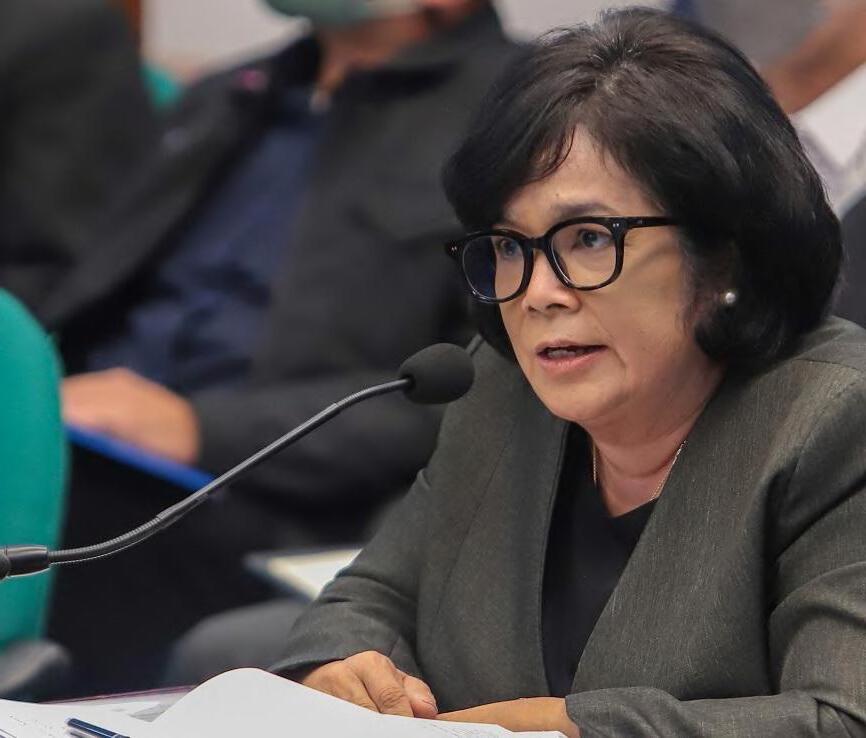


‘All thanks to Pres. Trump,’ app says
TikTok back for 75 days under Trump EO
United States President Donald Trump signed an executive order allowing social media platform TikTok to operate for 75 days until its parent company, ByteDance, sells the platform to a domestic buyer in compliance with recent legislation by the US Congress.
The platform resumed operations only 12 hours after the initial ban took place on January 19th.
‘Threat to nat’l security’
The platform was removed from app stores and web hosting services Jan. 19 after the United States Supreme Court (SCOTUS) upheld the Protecting Americans from Foreign Adversary Controlled Applications Act, banning TikTok for its alleged connections with the Chinese Communist Party.
Consequently, TikTok’s parent company, ByteDance, protested the act and filed an appeal with the Supreme Court on the grounds of a violation of freedom of speech and expression as provided in the First Amendment.
The judiciary ultimately dismissed ByteDance’s appeal and unanimously ruled in favor of the legislation, stating that the ban does not violate the United States Constitution.
“There is no doubt that, for more than 170 million Americans, TikTok offers a distinctive and expansive outlet for expression,
means of engagement, and source of community,” the court said.
The court elaboratedusa that the auctioning of TikTok is necessary to address Congress’s concerns about the app’s data collection policies.
Returning not for long
Long-time TikTok users resumed using the app Sunday after Trump signed an executive order.
“But Congress has determined that divestiture is necessary to address its well-supported national security concerns regarding TikTok’s data collection practices and relationship with a foreign adversary,” it added.
However, the app only remains available only for users who still have the app installed as app stores and web hosting services have not restored the platform.
What’s next
ByteDance asserted that its prized asset remains “not for sale.”
Trump said he is open to a “50/50 venture” between the US government and ByteDance.
“I’m thinking of telling someone to buy it, give half to the US, and we’ll give them a permit,” he said.
Meanwhile, American businessmen have reportedly reached out to Trump, signaling their interest in buying the app.
During TikTok’s ban threat in 2020, Walmart and Microsoft proposed bids to acquire the app’s assets in the US.
NO EXCEPTIONS.
President Ferdinand Marcos Jr. discredits assumed loopholes on Executive Order 74 on banning Philippine Offshore Gaming Operators (POGO) in a media interview on November 11, 2024.
Photo retrieved from NTVM.
LPSci wins overall champion in 2025 DSPC
By ALEXA M. LORENA
Las Piñas City National Science High School won best performing school during the Division Schools Press Conference (DSPC) Awarding at Talon Elementary School January 25.
The LPSci Standard Press was represented in six first place winnings out of seven top-3 finishers from the individual category, with all group categories earning top-2 merit.
Ang Paham, LPSci’s official Filipino publication, had eight top-5 awardees from the individual category and three group categories earning top-2 merit.
Forty-nine Lapiscians are slated to represent the city in the Regional Schools Press Conference on February 26-28 at St. Andrew School, Parañaque.
SPTA donates new sound system to LPSci
By QIANNE YAHJ D. ENRIQUEZ
The LPSci School ParentTeacher Association (SPTA) donated new sound system for the school court, October 16. Their donation included four speakers, a professional audio mixer, and wireless microphones with a rechargeable battery, all purchased from Konzert Philippines.
In its post, the SPTA expressed gratitude to School Principal Eleanor Honrales, the faculty members, Zamony Venture Corporation, and 9-Fairness Homeroom PTA President Jayson Refran.
LPSci DebSoc ramps up training efforts
The LPSci Debate Society held its first cross-batch parliamentary debate January 20.
As a joint venture with the English department, the event became a performance task for Grade 9-10 students while screening for potential talents.
A panel of the school’s varsity debaters evaluated the speakers per section, choosing two teams of eight students from each level to compete against the other.
The selected debaters then debated contemporary issues, including economics, religion, and morality, with the aim of spotting and rebutting logical fallacies.

Lechiu Property Consultants
(LPC) CEO David Leechiu said Dec. 28 that rental rates for mid-market (P3-6 million) condo units have already dropped to their lowest in about 15 years.
“The discounts are probably 10, 20, 30 percent of the purchase price. The rents are discounted at 50 to 60 percent,” Leechiu said in an interview with ANC.
Lovelle Taleon, director of real estate agency Santos Knight Frank, said a “silent fire sale” is underway among condominium property developers as LPC data as of November 2024 reported an oversupply of condominium units up to an equivalent of 34 months.
This means that it would take 34 months for the current inventory of units to be sold given the latest reported sales pace. LPC said the normal
oversupply equivalent is 12 months.
“The goal there is to sell it out. They don’t want to be holding on to the property anymore,” Taleon said.
Taleon said developers are keeping the sales under wraps, avoiding public promotions or large-scale advertising campaigns to prevent further market instability.
In its published report on October, LPC said there are 67,600 units across 510 actively selling buildings in Metro Manila, the highest since the COVID-19 pandemic.
Developers have also slowed project launches, declining by 39% from July to September, which LPC also said was the lowest since the pandemic.
Despite concerns, Leechiu said the issue is temporary and developers are not distressed.
“Hindi siya structural, fundamental crisis. We just built too much residential space as we also did in the office space. But
baha yan e. Over time, bababa yung tubig,” he remarked. LPC Research attributes the property value dip to a market preference shift towards single-detached homes in Metro Manila’s nearby provinces.
By AKI GABRIEL A. HERNANDEZ
parang
SLOWING DOWN. Condominium developers have reduced launches since July 2024 due to the 34-month oversupply. Photo from PHILSTAR GLOBAL
By SANTINO MIGUEL A. SANTOS
By LANCE KIANE G. SALUDO
LANCE KIANE G. SALUDO
By SANTINO MIGUEL A. SANTOS
related story From POGO To Purpose feature page 12

Cutting Corners: DepEd Budget Cuts
The Constitution, a timeless foundation of law, enshrines the importance of education at the national level. The government openly admits to cutting billions off the educational budget that struggling schools and institutions rely on for salvation—crossing the line between minor changes and outrageous modifications despite the rules.
The Philippine Congress recently created the 2025 National budget, which decreased P12 billion from last year’s distribution. This cut prompted strong opposition nationwide as the government failed to allocate financial resources in accordance with Section 5 of Article XIV of the 1987 Constitution, which prioritizes education as the most critical sector.



the final national budget, funds for the Department of Public Works and Highways (DPWH) were carved out from DepEd’s during the drafts of the final budget distribution.
More people are expressing concern over the government’s budgetary decisions, shifting their focus to the significance of the rule of law.
Despite legal mandates requiring the government to allocate the majority of funds to the education sector, it continues to suffer the most from budget cuts. Despite the Department of Education (DepEd) receiving P1.055 trillion Philippine pesos in
The Marcos Administration’s insistence on infrastructure was evident even after he vetoed the additional budget for the sector. This insistence not only demonstrates favoritism towards one sector over another but also suggests that the administration prefers to invest in infrastructure projects with limited lifespan rather than safeguarding the nation’s education, a lasting investment. Knowledge is one of the most important investments a person can have, yet it seems as if today’s leaders beg to differ.
‘‘ Although intangible, education is no less significant than concrete establishments and structures.
prioritizing education. According to ACT Teachers party-list Rep. Castro, the veto of the Marcos Administration of about P194 billion for DPWH projects was deceptive as they did not return the funds removed from the education sector. It is evident that Filipino students continue to struggle in math, science, and reading comprehension, yet education was at the back of the Philippine Congress’ minds as they made irresponsible decisions.

Prioritizing infrastructure opposes the constitutional law
Adjustments to the budget allocation to infrastructure should not come at the expense of reducing the education sector’s budget. Education is forefronted to equip the youth with adequate knowledge and preparation for the future that awaits. Although intangible, education is no less significant than concrete establishments and structures.

Chair of the Senate finance panel Sen. Grace Poe cites the P19 billion in DepEd’s budget increase for 2025 compared to the previous year, implying sufficiency. However, as modern problems require modern solutions, a modest increase in the annual grant will not suffice. Secretary of Education
Sonny Angara said lawmakers also stripped P1.5 billion from personnel services, or the money allocated for hiring new educators. Addressing the current shortage of teachers in public schools, DepEd seeks to hire 20,000 teachers in 2025 which would cost them a fortune of P20 billion. Perhaps the government is forgetting how material the world is today.
The government must be careful when allocating funds to the various sectors of the Philippines, as the actual cost of this budget may result in missed opportunities for future generations. Congress can do the necessary reassessment and proper management of funds to address the present issue. An issue remains persistent only when mismanaged—Congress can only improve from here.
Cutting corners and crossing lines will only hinder our nation’s progress.
SANTOS, 9-Fairness
lapiscianintuition.
Photo from ABS-CBN/Mark Demayo

90% OF LAPISCIANS DISAGREE
with the budget cut implemented towards DepEd in the 2025 PH national budget



WPoor Bet on the Veto
By TRISHA ANDREA V. ESPAÑOLA
Not much of a clear-cut decision came from the government: fumbling the General Appropriations Act (GAA) signed by President Ferdinand Marcos Jr. last December 30 with budget cuts. The Teachers’ Dignity Coalition were firm with calling it ‘unlawful’ how the allocation for the education sector this year fell short, insufficient at most. However, the administration did not just lack the funds, but struck a miscue following the slice of P12 billion to allot in the stead of infrastructure projects. How flawed can you be to sustain negative counter-reactions, one after another?
Mandated by the 1987 Constitution, supposedly, the education sector should receive the highest budgetary priority to ensure quality teaching through “adequate remuneration”, which TDC Chairperson Benjo Basas believes to be an unattained provision. Basas said that the government has lumped all agencies together to achieve the minimum requirement. They just perpetually prove how lazy they are with governing the state. I am inclined to think that the government supposes
the national budget is all just some silly blind date, allocating funds whilst eyes closed. The partner of the people who props up nothing but the bare minimum, unfaltering with ‘red flags’.
This relationship has already failed to meet standards as is, yet will continue to decline with international standards. As per House Deputy Minority Leader France Castro, the education budget should have been set at 6% of GDP from the start to meet UN standards— and of course, that was never the case. Instead, a carve from the budget. I am not saying that this country is needless of public works and framing, however, I affirm Basas and how he believes that the current budget for education should take center stage in our national agenda.
It has long been an underscored problem: the Philippine educational system lacking qualified educators, yet how can this be resolved when foremostly, authorities underwhelm the calls to necessitate quality education? They only had one job to critically fulfill, and they still turn out to be deficient.
On top of that, problems concerning funds do not end there— let’s talk about budget negligence.
How timely, isn’t it? A report from the Commission on Audit (COA) cited DepEd’s poor track record, revealing only 18% of the 2023 budget for ICT equipment is disbursed in accordance with the plan. 1-Rider Party-list Rep. Rodge Gutierrez took this into account while justifying the Congress’ decision to reduce DepEd’s 2025 computerization budget by an astounding P10 billion. Gutierrez dated back to the “problems and scandals” that Vice President and former DepEd Secretary Sara Duterte left in the agency during her time as leader, backing up his claim that the former just meant ensuring proper fund use instead of depriving education.
Leave the syllabus planning to the actual authorities in-charge in education, and not to self-proclaimed aficionados who think they’ve got what it takes to lead the education sector. Not only does it promote stagnation, it’s counter productive. We can’t continue grovelling over arrant nonsense. The education sector is unworthy of destitution— they wouldn’t want to pass over their dull intelect now, wouldn’t they? I await the time it registers in their minds that the state of the nation is a mirror to their tenth-rate sense of jurisdiction.
China’s Choleric Contempt
By CYREE ELISHA B. PAMPLONA
aves are splashing, almost as if they are mixed with blood. Air is blowing, and you can almost hear the screams. Whispers of helpless, yet hopeful murmurs of the Philippine Coast Guards (PCG).
China Coast Guard (CCG) vessel 5901, known as the “monster ship” due to its massive size, was found patrolling near the coast of Zambales, Philippines, within the country’s exclusive economic zone (EEZ). The Philippine government has demanded the immediate withdrawal of this vessel, describing it as an “unacceptable intrusion” into its Exclusive Economic Zone (EEZ). In response, on January 9, 2025, CCG
‘‘ The number of PCGs that have been violated and threatened by the CCG is significantly increasing— and it’s scary to picture what the future holds for us, regular citizens, if China’s aggression towards us heightens.
sigh in relief, their wrath surely does not end there. As the tension between China and the Philippines arises, the fear of being left with nothing but defeat still lingers in the hearts of many Filipinos.
Despite the departure of the ‘monster ship’, the CCG made sure to leave remnants of them to guard our coast. The ship was replaced by a smaller vessel that immediately assumed its original position. The number of PCGs that have been violated and threatened by the CCG is significantly increasing—and it’s scary to picture what the future holds for us, regular citizens, if China’s aggression towards us heightens.
I have seen countless news articles about China since last year. Not to exaggerate, but there was a week wherein I could not see headlines that didn’t involve China, the West Philippine Sea, or the Trilateral Agreement for that matter. Unfortunately, we remain at China’s mercy.
In January 2025, U.S. President Joe Biden, Japanese Prime Minister Shigeru Ishiba, and Philippine President Ferdinand Marcos Jr. held a virtual meeting to address China’s “dangerous and unlawful behavior in the South China Sea.” The leaders highlighted the need for ongoing collaboration to ensure a free and open Indo-Pacific, reaffirming their dedication to enhancing economic,

by JAMEELA L. CABORDA


Wbythenumbers.
the Philippine government has considered all options, including potential international legal actions, to address these provocations.
According to Foreign Ministry Spokesperson Guo Jiakun in a press conference on January 7, 2025, the CCG’s actions are in full accordance with the law. “It is fully justified,” he said. However, are the threats that come with it legal, too? Are we to believe that their patrolling and law enforcement activities do not have dirty motives beneath them?
Undeniably, their actions continue to violate international law and the 2016 arbitral ruling. The Philippine government must do its best to avert its attention and allocate funding for the PCG to be able to maximize its strength in protecting our shores. We may seem helpless but this is not the time to lose hope. With proper strategies and smart tactics, we will be able to own our land without China’s attempts to drive us away.
The continuous presence of China within our EEZ serves as a clear sign of ongoing threats to our sovereignty. In spite of diplomatic objections and legal successes, like the 2016 arbitral decision that nullified China’s unhinged claims in the South China Sea, yet they persist in their dominance through aggressive maritime actions.
We have had enough struggles, shed countless tears, and have gone through so many conflicts with China. Yet nothing is more intimidating than the looming shadow of China’s choleric contempt. This is the moment to rise and fiercely defend what is rightfully ours. Our sovereignty is not up for negotiation—it is time to fight with conviction and claim our rightful place with unwavering courage.
By JACOB KRISTOV L. NOBLE
“The welfare of the people is always the alibi of tyrants.” Albert Camus
From Gaddafi to Mussolini, dictators have proven time and time again—only the people hold the keys to freedom--words that are still true today. In the late hours of December third, South Korean President Yoon Suk Yeol declared martial law, an act that sent shockwaves through the nation. It was thwarted by the action of the National Assembly—quickly reversing the act, mere hours after the fact, preventing the inevitable elimination of liberties.
The government argued that the declaration was necessary, but I recognize it for what it was—a desperate attempt to stifle the people and to consolidate power. President Yoon Suk Yeol has always been a controversial president, with his administration riddled with controversy, ranging from lawsuits to restricting the freedom of the press. One of the most significant controversies concerns his wife, whose scandals range from her plagiarizing her thesis for her master’s degree to her accepting bribes, drawing heavy criticism. Yoon, however, has blocked any investigation that targeted his spouse, raising questions about his commitment to transparency and accountability.
As a political junkie and casual historian, I couldn’t help but notice the similarity of Yoon’s actions to those of past dictators, always repeating the same rhetoric, ‘For the people’. A great example for us Filipinos is the late Ferdinand E.Marcos Sr., whose statements sound strikingly similar to Yoon’s. Yoon justified his actions as necessary to stop foreign and domestic agitators from disrupting the country and to prevent it from falling into ruin. These are almost indistinguishable from what Marcos Sr. had used to justify his own declaration of martial law. Yoon and Marcos are also infamous for restricting press freedom, censoring critical coverage of them and their allies. Both cases show a “leader” who is willing to go to extreme measures to consolidate power
South Korea prides itself as a beacon of democracy, which remains unwavering. If not for the brave actions of lawmakers— crossing party lines to reach a decision without politicking, many would be living in a very different South Korea. This should serve as a wake-up call not only to South Koreans, but also to all nations who cherish democratic values. Democracy is frail but the people are mighty.
As of February 3, 2025, China Coast Guard (CCG) vessels have maintained a continuous presence off the coast of Zambales for
Source: PHILIPPINE COAST GUARD
Natural Fortress in Peril
By AVA JANELLE R. LIM
hear heavy rains pouring and feel strong winds howling, we immediately seek cover and wish for the storm to pass. But how often do we pause to think of the silent guardian that carries the weight of nature’s fury—the Sierra Madre?
range, Sierra Madre is not just a tourist attraction—it is Luzon’s primary shield against torrential rain, saving millions of lives. Actually, a
study in the Philippine Journal of Science noted that it reduces wind exposure by 1-13% and rainfall by 10-59% in the Cagayan Valley. In addition, the PAGASA Annual Report on Philippine Tropical Cyclones 2020 presents how Typhoon Ulysses weakened to a severe tropical storm after passing the Sierra Madre, the plains of Central Luzon, and the Zambales Mountains. Yet why is it still being overlooked?
I have learned about Philippine landmarks like the Banaue Rice Terraces and Chocolate Hills
in school. But Sierra Madre? Its importance was barely mentioned. I later realized that this mountain range holds our future—mitigating disasters and supporting countless livelihoods. This lack of awareness saddens me because I have seen how it fuels deforestation, illegal logging, and exploitation, all of which contribute to climate change. In fact, carbon dioxide emissions were projected to reach 41.6 billion tonnes in 2024, further worsening extreme weather events, according to the Global Carbon Budget.
Challenges and Threats
Over the past year, Luzon has experienced cyclones causing severe flooding and landslides. I personally have witnessed how netizens expressed their gratitude for Sierra Madre on social media because, if not for it, the destruction brought by the storms might have been worse. Its elevation absorbed the rainwater, slowing its flow to reduce flooding, while its rugged slopes weakened strong winds, ensuring a balanced rainfall. However, how long can it continue as “Luzon’s backbone”? Despite its contributions, it is deteriorating due to illegal activities, and it will remain at risk if we do not value it.
What We Can Do It is time for action—genuine though simple. Raising awareness

about Sierra Madre’s importance will encourage people to support conservation groups, donate, and sign petitions. Laws against illegal logging, mining, and land conversion must be pushed, and carbon footprints must be reduced by planting trees, practicing proper waste disposal, and conserving energy. Let us ensure that future generations will not only learn of a once-great mountain range, but will live under its care.
Ultimately, the fight for Sierra Madre is a fight for the future of our youth. Its survival depends on our actions today because even if it shields us from nature’s anger, it cannot protect itself.
Saving Sierra Madre means saving lives, dreams, and the future of our nation. Now, Sierra Madre is calling. Will we answer?
ironicallyenough.
silentguardian.
Art
Photo

Solons: Sex ed ‘too lewd’
to teach
By SANTINO MIGUEL A. SANTOS
The passage of the Reproductive Health Bill in 2012 was seen as a milestone by progressive leaders in the country. Despite numerous backlashes from the conservative sectors of society, the bill nevertheless was transformed into law upon passage by both chambers of Congress.
The RH Law was passed not more than thirteen years ago, by a Congress arguably more progressive and peoplecentered than our legislature today. It is an absolutely laughable fact, an absurd one too, that our lawmakers would rather prioritize upholding a legacy of being a ‘conservative’ country with ‘conservative values’ instead of looking at the truth head-on.
Now, more than a decade later, Senate Bill 1979 attempts to remedy teenage pregnancy via the development of better comprehensive sexual education (CSE) programmes in the country. Critics, including the president himself, say that ‘woke absurdities’ like ‘teaching children how to masturbate’ prevent it from passing Congress and becoming law. One thing – I have read the bill in its entirety, and I can assure you there is no mention of the word ‘masturbation’ at all. You cannot fight debauchery when it does not exist.
What is in the bill, however, is an attempt to get Philippine sex education to be on par with well-meaning yet vague “international standards”.
Detractors of the bill point to the Standards of Sexuality Education in
Europe, which, factually, does contain provisions that children aged 0-4 years old should be taught about “enjoyment and pleasure” when “touching oneself”.
Aside from this, opposition to the bill has rallied around the State supposedly interjecting in matters of parenting and education. Critics side with the fact that even though the bill wants to improve sex ed infrastructure in the Philippines, the parents’ role as child-rearers and their guides are vastly diminished. This is due in part to the bill allowing minors to obtain ‘alternative consent’ from licensed social workers or a doctor.
While those concerns are valid, I think the most perennial issue at stake here is not the parent’s role in sex education but the actual goal that the bill wants to achieve – reduced unwanted teenage pregnancies. I do agree with the opposition that the bill needs some work done to find middle ground between the largely conservative majority and its sponsors, however, when it comes to the future of the Philippine nation, I side with the side that wants to mitigate these harms via a large-scale, law-supported method.
Sexuality education and human sexuality in general remains somewhat taboo in our conservative nation. But it is this discussion of sex in schools that allows students to see what is at stake once they attempt risky sexual behavior. From 2021-2022 alone, Save the Children Philippines jotted down a whopping 35% increase in teenage pregnancies, that too between adolescents aged 15 and under.

New Conversations for Old Controversy
By AUDREY P. MONCERA
Peace never seems to be an option for people in showbiz, doomed to blinding camera lights until their very death.
Director Darryl Yap has recently released a new teaser that’s stirred up not only social media but the very courtroom itself for his upcoming film, ‘The Rapists of Pepsi Paloma’ – a “truthful revelation” surrounding the alleged rape and untimely death of the late actress Delia Dueñas Smith, also known as Pepsi Paloma, who was famously one of the “Softdrink Beauties” during the Golden Age of Philippine Cinema in the 1980s.
The teaser is a dramatization of
becoming the centerpiece of Pepsi’s highly publicized court case in 1982. Sotto would promptly file 19 counts of cyber libel against Darryl Yap, and though the Muntinlupa Regional Trial Court barred them from releasing public statements, Sotto and Yap’s legal battle reignited the public’s curiosities on the 1982 controversy chalked full of mysteries and speculation.
For sure, Darryl could’ve predicted at least half of the online and legal backlash in making his film, which begs the question: Why bother? Is producing a biopic—at the cost of digging up decades worth of allegations that leave a dark stain in Philippine entertainment history—even worth an ounce of justice to the late Paloma?
the storyline being based on public documentation and accounts of Paloma’s family, portraying the late sexy star as the “victim” she is. While word of Yap’s intentions sounds genuine—even heroic—at a glance, his online statements in defense of the film play an incautious, off-putting tone as he confronts online trolls and critics alike.

3,343 births to mothers under 15 in the Philippines, a 39% increase from 2,411 in 2019.
bythenumbers. In 2023, there were Source:
AUTHORITY

A2019 2023
After all, what problem do we have if CSE gets integrated into the Philippine curriculum? Is it a problem for our children to learn that they have rights over their bodies? Note that the Philippines only raised its age of sexual consent to 16 years old just three years ago in 2022.
Indeed, it is the policy of the state to look after the wellbeing of its citizens. However, when lawmakers put religion and highfalutin standards of morality first before actual concrete solutions, it is us, the laymen, who suffer.
To our lawmakers – I implore you to set aside your religious affliation and conservative reservations and work with each other to develop a better, sexuallyinformed Philippines.

Dignity Beyond Stereotypes
By KIM ANTONETTE P. ARPIA
viral video of a 22-year-old Sampaguita vendor being mistreated by a mall security guard has left many of us feeling heartbroken and angry. This young woman, later revealed to be a scholar at a private school, has been selling flowers to support her family after her home was demolished. The incident captured on video is a reminder of a growing trend in our society—the tendency to stigmatize those who appear poor or are hustling to survive as “bad” or problematic.
Why is it that someone who sells Sampaguitas or hustles in public spaces is often seen as a nuisance? Why do we associate people who look “poor” with trouble or dishonesty? She isn’t a threat; she’s a scholar—bright, hardworking, and supporting her family. Yet in that moment, the guard saw her as ‘less than human,’ someone to be dismissed and mistreated.
A WIEGO survey from 2019

Tfound that a large percentage of street vendors experienced harassment and abuse from authorities, including police and city officials. Outrage over the Sampaguita vendor shows that people still care about fairness and empathy. But what happens after the anger fades?
The truth is, her story isn’t unique. I see vendors—women selling Sampaguita, men pushing carts of Taho. Some are old, with their backs bent from years of hard labor, while others are young, balancing trays of snacks as they weave through traffic. They contribute a lot to our daily lives but lack basic protections, face constant systemic neglect, and are denied access to basic services.
According to the Philippine Statistics Authority, the informal sector contributed P5.013 trillion to the country’s GDP in 2016. This undeniable economic impact highlights the sector’s importance, yet it remains undervalued and unsupported.
Walls Of Injustice
By LIFE KIRSTEN P. CRUCILLO
here is no doubt that the Philippine prison cells are in a crisis. According to Free Documentary’s Video uploaded in 2023, Manila City Jail was designed to accommodate 1,100 inmates but now houses over 8,000. There are 90 individuals in every 25 square meter cells. With only one bathroom per cell, I won’t even be surprised if a new epidemic breaks out in our prison cells. An alarming scarcity of food was also revealed in the documentary. An inmate admitted, “It is OK. Enough to survive but so little to fill our stomach.” Prisoners eat in cramped, dingy cells since they don’t have a canteen, a systemic failure that breaks the basic rights of living.
In South Cotabato Jail, many inmates remain unconvicted as they waste their years awaiting trials that might never come. According
to Inquirer journalist Kathleen de Villa, “3 in 5 prison jails are bursting at the seams.” To describe in detail, the Commission on Audit shows that 112,457 Persons Deprived of Liberty (PDLs) are crammed into a 216, 788 square meter. This overcrowding is proof of the human rights crisis that highlights incompetencies in the judicial system.
I would like to raise critical questions such as: Is overcrowding due to police catching more criminals, or does it reflect a justice system that prioritizes record over fairness? Some incarcerated individuals may not even belong here. People waste over a decade in prison without being able to establish their innocence. Justice delayed is justice denied. I can only imagine the psychological strain of such prolonged uncertainty, paired with the physical burden of living in inhumane conditions.
Respect alone isn’t enough; Their struggles stem from authorities mistreating them in contrast to the privileged. Ensuring vendors’ rights through fair policies can prevent the criminalization of poverty. Successful initiatives worldwide demonstrate that change is possible. Countries implementing inclusive urban policies— such as Thailand’s regulated vending zones—have seen increased economic stability and reduced tensions between vendors and authorities.
The Sampaguita vendor’s story reminds us of the humanity behind the hustle. She is not just a “peddler” but a young scholar with dreams. Despite systemic neglect, her struggle is just one of countless others who contribute to our society. Imagine a society where authorities act fairly, offering opportunities rather than obstacles. Yet these injustices persist, hidden in the loopholes and blind spots society chooses to ignore, quietly reinforcing inequality.
I am in no way justifying heinous crimes but punishment should not equate to cruelty. Depriving inmates of food and making them endure degrading conditions is unjustifiable. You can take away freedom as a consequence of wrongdoing, but basic rights must prevail. Are you aware that dehumanising them may only lead to cycles of violence? They are more likely to change their behavior into law-abiding citizens if treated with respect. Moreover, not all accused are guilty. You don’t want to be a false carrier of justice, right? It is a must for the government to urgently address this crisis. Start reforming the prison system, pursuing timely trials, and improving conditions, so we can create a justice system that balances accountability with humanity. Treating prisoners with dignity validates that justice is for all, even for those who have erred. Let fairness guide us, not unjustness.
If the director himself were to answer, lying about Paloma for a film isn’t worth putting himself in hot legal water. Yap denies on his official Facebook page any personal or political motives against the Sottos, emphasizing
Movies involving true crime are nothing new to the public eye, not even to the most traditional Filipino. However, one thing that is constantly clear within the genre is the importance of handling tragic cases with caution and diligence. Despite hopes of “Pepsi going back to court and Filipinos back to cinemas,” clearly, Darryl Yap holds the story of a reported rape victim as recklessly as the media that once sensationalized Pepsi’s story into a nationwide scandal; Yap himself previously associated with sensationalism and historical revisionism in his works.
If Yap truly intends to bring tribute to the young Pepsi as a fellow Olongapeño, one must be careful with his status and the volume of his rebuttal so as not to overshadow the silent voices he claims to raise. Indeed, no one has a monopoly on justice—but if the approach lacks dignity, he might as well be disturbing the grave of Pepsi Paloma herself.
‘‘ Is producing a biopic— at the cost of digging up decades worth of allegations that leave a dark stain in Philippine entertainment history— even worth an ounce of justice to the late Paloma?
NAZARENO: Himala o Haka-haka?

‘‘
Contrary to popular belief, especially for a community like ours. There’s no lie that wonders are truly formed when determination and opportunity meet. What I mean to say is, that even if we believe and love our almighty creator, it doesn’t need to be stored or seen through physical means for which we would go to unreasonable lengths for. Faith can be within our own hearts, reflected through our actions. The real powerful wonder is the relationship we each have with our spirituality and God.
• GEORGINA AMBER P. GULPANY, 9-Faith
Growing up as a Catholic, I have always been taught to believe in church beliefs. Although I am not a very religious person, I still have my faith. The Nazareno is one of the religious images or statues that I believe can bring “himala” into our lives. What made me think of that is because my lola also has strong beliefs about it. She would pray and ask for healing or miracles whenever there’s a circumstance in our life and I have seen that her prayers are answered which made me also believe that the Nazareno is a piece who can bring miracles in our lives.
• JANA LOREAL L. ORENDAY, 10-Imaginative
I understand why some people might see the Feast of the Black Nazarene as a disturbance, especially with the large crowds, road closures, and disruptions to daily routines. However, I believe it’s important to look at this event from a holistic perspective. As a devoted Catholic, I believe that this celebration represents our deep cultural and spiritual heritage, showcasing the unity, resilience, and faith of our people. It provides a rare opportunity for Filipinos to come together in solidarity and prayer, which is especially meaningful in a society where challenges often test our resilience.
• AUBREY L. COMETA, 11-Compassionate
Devotees believe that the Black Nazarene statue brings out miracles once you touch it. To cure disease, lure success, and restore lost relationships. But as the saying goes, “Nasa Diyos ang awa, nasa
• PATRICIA N. SEÑIRES, 12-Honesty
lapiscianintuition.
Art by ANNE THERESE CASSANDRA D. TAN
Photo retrieved from SAN FELIPE NERI PARISHMANDALUYONG CITY/Facebook

opinion. 08 STANDARDPRESS

Too Young To Realize
By LHYNDELLE ANGELA G. RAMOS
At the age of six, we found life simpler. We would spend our time playing in playgrounds, sitting on swings, climbing up the monkey bars, or riding the seesaw. How cruel it is that one day, a child would end up being afraid to go back to the very place that once made them happy.
It’s wishful thinking to believe that this is just a vivid illusion. Tragically, this is the harsh reality. In Mabalacat City, Pampanga, two boys, ages eight and ten, allegedly raped a six-year-old girl. According to police reports, the girl was playing with her younger sibling on a basketball court when she was grabbed and taken to a grassy area, where the alleged incident occurred. This tragic incident is not isolated. It is part of a much larger problem that affects millions of children.
Imagine your child going home from a day of play, and instead of telling you how much fun it was, she shares a painful experience. But who is to blame? Is it those responsible for the harm, or the parents and systems who neglected to teach and guide the children?
Yes, the boys involved are minors. As disturbing as it is, those who are responsible for them must be held accountable. Neglecting to teach children values leaves them vulnerable to making choices they don’t fully understand, making them unaware of the consequences of their actions.
According to the CAMELEON Association, about seven million children are subjected to sexual abuse every year in the Philippines. Of these, 20% are under six years old—children too young to fully comprehend the horror they face. Despite the Anti-Rape Law of 1997, however, rape remains the most common form of abuse. This only shows that laws alone are not enough to protect children.
It’s so alarming that these cases are becoming more frequent, yet the media is barely making a dent in public consciousness. It feels as though our society is becoming numb with these tragedies dismissed as mere headlines instead of calls to action.
We need to invest in dedicated child protection units, mandatory reporting, and offender rehabilitation. Provide trauma-informed counseling for victims. Implement parent education programs on child development, boundaries, and online safety. In the end, pity without action is empty empathy. The cost of silence is far too great to bear, and it is a burden that no one should have to carry.

Inept Attempt to Adapt
By JOSE YNIGO U. PANGILINAN
Amid the constant and relentless chain of events that shake our nation to the core, education is a vehicle we students ride to navigate this rocky, ever-changing landscape. But even as the terrain became bumpier, the driver somehow thought it would be better to accelerate than to slow down — and inevitably, we crashed.
In April 2024, The Department of Education (DepEd), under the leadership of Vice President and Education Secretary Sara Duterte at the time, announced its plan to speed up the shift of the school calendar back to the pre-pandemic June to March schedule following stakeholders’ concerns on the severe summer heat. However, its execution thus far suggests a lack of consideration for comprehensive, full-fledged learning. The schedule per DepEd Order 009, S. 2024 shows that the number of school days per quarter has decreased. Most academic quarters this year span around eight weeks with the 2nd Quarter being the exception, lasting barely ten weeks. In contrast to previous academic years, one quarter would typically last ten weeks.
This calls into question DepEd’s commitment to improving basic education in the country; while it is imperative that the school calendar be reverted to adapt to the summer heat, it is just as important for students to fully reap the benefits of education. Though DepEd may have chosen to speed up the shift due to logistical reasons, budget constraints, or pandemic-related disruptions, it is also responsible for ensuring its implementation is well-planned and realistic. The shortened school year forces teachers to rush through lessons just to complete learning competencies on time. Consequently, students must learn various concepts rapidly, putting holistic learning at stake as true appreciation for topics may be left behind. Furthermore, when you remember the Philippines’ 2022 Program for International Student Assessment (PISA) performance where we ranked 77th out of 81, it seems that we are only digging a deeper grave for ourselves.
If the goal was to maintain quality education while avoiding the scorching summer heat, then efforts should have instead been made to enhance the effectiveness of alternative delivery modes coupled with a more gradual
shift of the school calendar. While these modes require tweaking, isn’t it DepEd’s job to be adaptive and find ways to keep the flow of education going even though problems like severe heat persist? Even if many struggle because of a lack of resources or access to technology, DepEd has the power to aid those people. Yet, under VP Sara, the education department spent P112.5 million confidential funds back in 2023; that says a lot about where the department’s priorities were.
Additionally, the calendar’s breaks are unusual. The so-called ‘midyear break’ in the last week of November was not even a full week of rest, as the order allocated the first
‘‘ In the scene of the 21st century, DepEd simply cannot fall behind and refuse to expand its options.
three weekdays for distance learning. For us Lapiscians, we were met with a decision more inconvenient, as a regional memorandum declared that those days were replaced with make-up classes to cover suspended school days from Typhoon Kristine. While I have no problem making up for those days lost, the issue is that those three days were treated as a reserve or backup, making the midyear break feel more like just a long weekend. The break was also immediately followed by the 2nd Quarter Examinations, driving many students, including me, to sacrifice rest for studying in fear of tanking the tests.
More recently, students also expressed frustration over the short Christmas break that lasted for a week and a half, compared to the usual two weeks. The final nail in the coffin was having classes resume on January 2 — right after the holidays. It seems that DepEd forgot the value of ample breaks.
DepEd said extensive consultations were held with parentteacher organizations, curriculum specialists, student leaders, and field personnel to arrange the calendar shift. Yet, its execution makes me wonder if DepEd did enough work on the ground to grasp how it would impact our learning. As we deal with its repercussions, it is no longer in the hands of VP Sara to compensate for it as she resigned from her position as DepEd Secretary back in June 2024. Now, it is up to the current DepEd Secretary, Senator Sonny Angara, to bridge the gaps it has created for us, the students. I hope that under Angara, the education department will not only continue extensive consultations but also heed students’ calls and fully consider the rippling effects of the department’s plans. It is crucial that DepEd, under new leadership, prioritizes both the well-being and the quality of education through thoughtful reforms. Furthermore, DepEd should explore modes of learning outside of faceto-face learning, and ensure these modes are accessible to all students. In the scene of the 21st century, DepEd simply cannot fall behind and refuse to expand its options.

Although VP Sara’s resignation shows a lack of accountability for her several blunders in the education department — like this academic year’s calendar — knowing incompetence no longer runs DepEd gives me

To the Editor,
I am writing to raise a significant concern regarding the academic needs of students in public science high schools. Students are often tasked with projects that require materials, equipment, or resources that are beyond what the school can provide. I respectfully believe that having an allowance system to support students will benefit everyone effectively.
Preparing for science fairs, joining several competitions, attending school events, and conducting school experiments are associated with financial costs that may be burdensome for many families.
An allowance would ensure that the demands of the school to students would be met efficiently. Moreover, it promotes inclusivity and allows learners to perform to the best of their abilities. Without adequate financial support, some students may feel left behind and be hindered from their full potential.
I hope this proposal will be considered for the betterment of our schools as it is one step closer to enhancing the education and opportunities of our public science high learners. Thank you for your time and attention to this concern.
Sincerely,
LIFE KIRSTEN P. CRUCILLO Grade
11
Greetings!
Thank you for raising this issue. It is truly concerning that we, science high school students, are tasked with different projects and requirements that often require more than what we can give. Alongside that, I agree that the financial costs needed to prepare for various competitions and events can be taxing for participating students.
Providing an allowance for science high school students would not only give them the opportunity to meet the demands of various tasks but also maximize their learning and knowledge. It would allow students to learn without worrying about falling behind due to finances.
However, though I believe that an allowance would be beneficial, this concern also calls for a reform in the way our educators assign us various tasks. Teachers and event organizers should consider the capacity of students to carry financial costs and ensure that everyone is realistically able to meet their requirements. Only then can we have an education that genuinely benefits all. Until then, an allowance remains our best bet. This letter will serve as a spark for change and improvement regarding this issue. Rest assured that we are carefully reviewing this matter.


ABy SATRIAH ARYAM C. MANSUL
n investment in knowledge is an investment in a progressive and developed community. Each day, when a school starts its classes, a nation has the potential to make productive progress, where each hour and minute cannot go to waste. This truth is evident in the School Division of Las Piñas City, as the education of the youth serves as one of the top priorities on their list of improvements— specifically, providing materials— after the disappointing results of the Programme for International Student Assessment (PISA) in 2022.
With the demotivating results of the Philippines’ 2022 PISA report, new plans and strategies to address students’ evident learning gap are needed for the educational growth of the community. According to ABS-CBN News, the PISA measured 15-year-old students’ ability to generate, evaluate, and improve ideas to produce original and practical solutions. Unfortunately, the Philippines ranked 60 out of 62 countries after gaining a PISA score of 14.
Since the harsh reality set in for Las Piñas City, its government took swift action. According to Dr. Macario D. Pelecia, the Educational Program Supervisor at DepEd Las Piñas, the
Dreamers Left Dreaming
By SEAN ANTHONY M. BARBIETO undermined
Aschool’s main purpose is to foster and facilitate the growth and talents of students. The foundation of this institution is the promise of equal opportunity, potential development, and the establishment of environments that allow dreams to grow. So when outstanding individuals are recognized, it seems that only that specific batch is to be supported and allowed to grow and flourish in that area of academia. Those individuals from our school might range from the students participating in extracurricular activities, to the minds we have in the star sections of our JHS. This way of special highlighting discourages active engagement and incorporates the idea of perfection when a school should be open to mistakes. A school should institute better learning spaces for students.
Though it isn’t a bad idea to applaud and praise those who have definitely shown exceptional talents, sometimes it leads to unjust conclusions when excessively done. Just because there is already someone available to take the role for a certain academic role,, we begin to think that we don’t have what it takes, and we don’t need to anyway. There is a highlight of an “I” in that “we”, as this is exactly how I felt. A way to combat this way of thinking is through active interactions by teachers showing that despite not being the greatest at an area of academia, there are still other areas where they can excel; schools should simply be more eager to help students realize their potential.

In the context of extracurricular activities, it has come to my attention that the members of competitors representing LPSci are mostly from a certain batch. And so when that batch of students leaves and graduates, what now? When they’re finished with their high school, who is to be the next in line? It gives rise to the accusation that the school moreover only finds aspiring talents in times of scarcity instead of welcoming talents with open arms. Since it always seems to be the same people competing outside schools, the only active people disciplined by the school themselves are those already with a stable foundation.
Although no educational system we have ever used gives certainty to the promise that it allows every student to grow and realize their potential. It’s still a concept worth putting effort into and trying to achieve. As through active encouragement and schools assuming more responsibility, they could quite literally save lives just by simply helping students realize their potential. And through this interaction, students may also be open to having more confidence with their own abilities, because who else would there be to realize your own potential aside from your own selves.
No Pupil Left Behind
Division Office had provided various validated learning materials and printed sources for the students who have difficulty keeping up with their peers in school.
This course of action is not simply the duty of the government; it is a way for our leaders to show that they genuinely care about the welfare of our struggling students. Providing these materials to Las Piñas students shows compassion and understanding as they push through with having quality education.
In my experience, many students and teachers in my school were elated to know that the educational material was sufficient for the entire school’s needs. There would be trucks entering our school monthly, providing us with Learning Assessments, Worksheets, modules, and tests without missing a beat. My previously struggling classmates find themselves at ease with the help of various reading materials and strategies.
The city’s initiatives in education, such as the earlier implemented Catchup Fridays, helped operationalize the National Reading Program, Values, Health and Peace Education, and Homeroom Guidance Program. With the various subjects to be taught, my
classmates are now being exposed to more knowledge, like eager sponges faced with the water of enlightenment. Adjusting teaching strategies enables students to catch up to their peers and take steps ahead to progress. Such initiatives provoke mental development, instill good morals, and encourage a holistic approach. Access to quality education enables students to think critically and impactfully solve problems while demonstrating empathy and resilience. Since schools are the basis for continuous learning and the development of children’s imagination, communities must sustain the program for every learner to receive opportunities to improve in their journeys to enlightenment, consequently creating responsible and knowledgeable citizens in the future.
With authorities proposing and implementing this variety of programs, students should help themselves with the abundance of content provided to keep us from falling behind our fellow students. As evidenced by the PISA results, it is important for our government to intervene and for our young pupils to push themselves into the light of owledge.
With knowledge instilled in young minds, no pupil will be left behind.
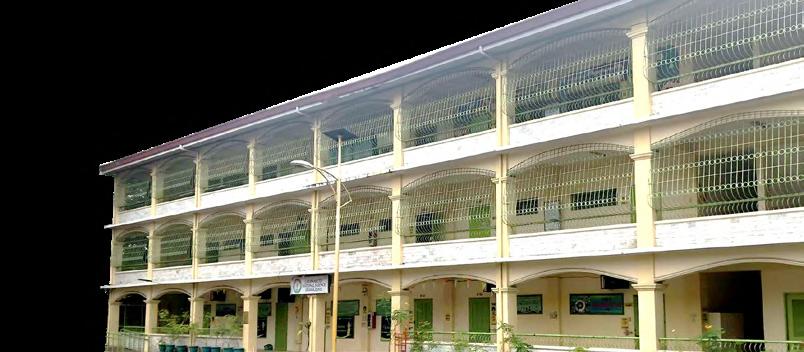
vividillusion.
enlighteningtwilight.
Art by JAMEELA L. CABORDA


Inside the dark trade of infant trafficking
OBy BWAN LILA AGUHAR and SATRIAH ARYAM C. MANSUL
n August 7, 2019, Sandra reached out to a potential seller of an unborn child through a private message on Facebook.
“Good afternoon po. Interested po ako. Paano po ba? (Good afternoon, I’m interested. How does it work?)”

She had come across the woman’s comment in a Facebook group, where babies— both unborn and newborn—were being openly advertised for illegal adoption.
In an interview with The Standard Press, Sandra, whose identity is being withheld for protection, admitted that she and her husband had previously adopted two children through similar transactions.
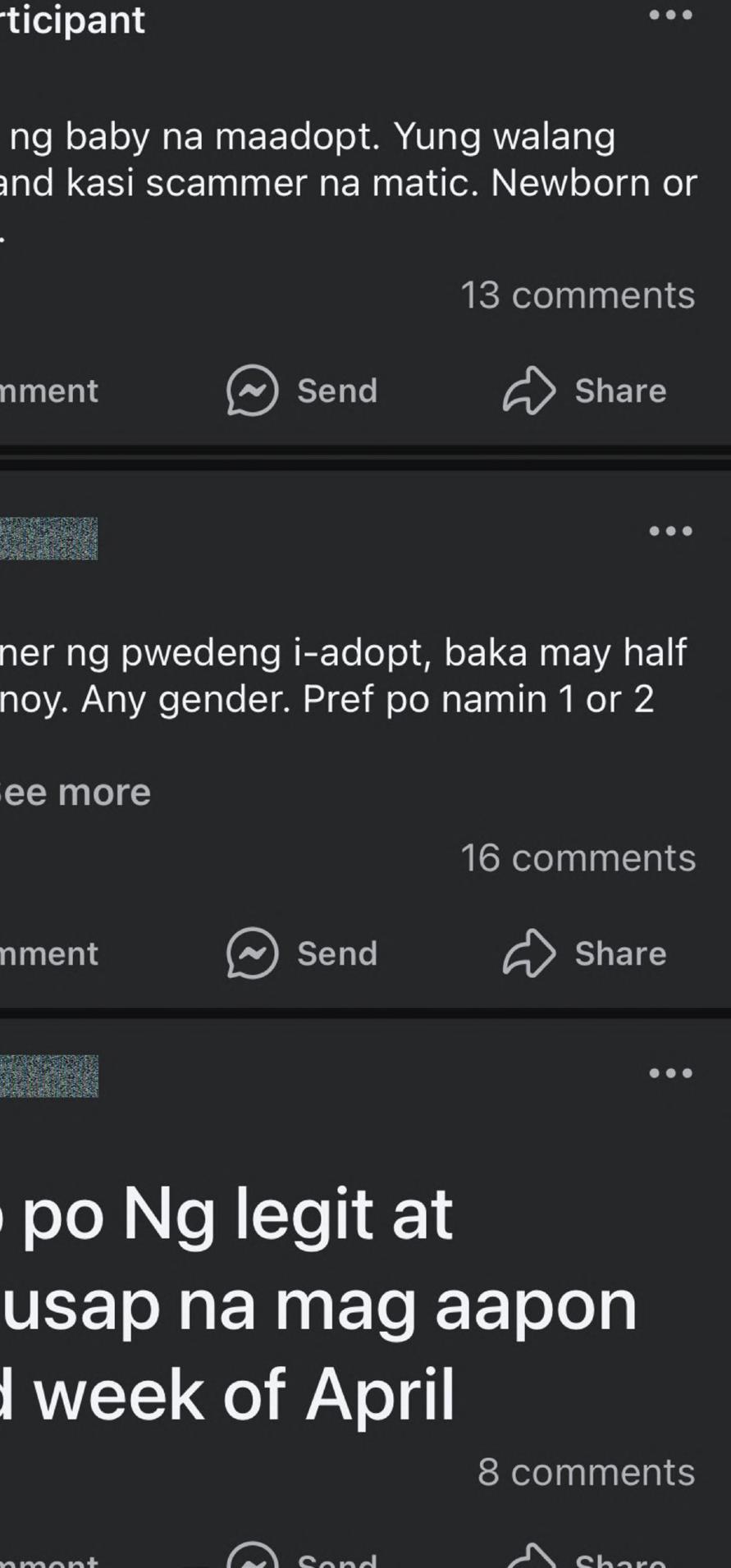
“May dalawang anak na ako, parehong sa online ko nakilala ang mga magulang nila. Hindi kami dumaan sa legal adoption kasi maproseso at magastos. Sa Facebook groups dati, madali lang makahanap. Pero ngayon, alam ko, strikto na sa Facebook. (I have two children, and I met both of their parents online. We didn’t go through legal adoption because it is a long process and it is expensive. Back then, it was easy to find children in Facebook groups. But now, I know Facebook has become stricter.)”
Sandra is unable to conceive. That was the reason she and her husband turned to these underground networks. Their first child was financially supported from pregnancy to birth, while their second child was obtained for P10,000.
“Ang ginawa namin, pinalabas naming kami ang biological na magulang. Tapos pinaregister namin sa NSO. (What we did was pretend that we were the biological parents. Then we registered them with the NSO.)”
Though they have hidden the legal truth, Sandra and her husband are slowly introducing their children to the reality of their adoption.
“Alam ng mga bata na hindi namin sila tunay na anak. Dahan-dahan naming ine-explain.
Pero mga bata pa sila. Siguro paglaki nila, pag gusto na nilang malaman, handa na kami para ikuwento sa kanila yung totoo. (The children know that they are not our biological kids. We are explaining it to them little by little. But they are still young. Maybe when they grow up and want to know, we will be ready to tell them the truth.)”
A Hidden Trade
Online infant selling has always been present within the darker pathways of the web.
Posts are being shown on high-profile sites such as Facebook with captions describing the children like “5-month-old baby in Central Visayas” and with responses flooding the posts with queries on how to claim the said child. This was extremely similar to the situation of a 7-month-old infant that was sold for P35,000 on social media before she was rescued by authorities in Rodriguez, Rizal.
Since the rescue that transpired on November 6, 2024, with a 29-year-old suspect as the culprit, the fact that there is a complete operation in selling these babies from biological mothers to information brokers makes it clear that this issue has been plaguing Netscape for a long time.
The government continues to monitor this activity online as the National Authority for Child Care announced that the Philippines is observing 23 Facebook pages that host the online sale of babies. These Facebook pages sell children within the range of PHP8,000 up to PHP100,000, whittling these infants down to objects that are bought from stores.
Infant trafficking has also been occuring in other parts of the world, like Russia, United States, Europe, and Asia.
Hope or Exploitation?
Comments expressing interest in purchasing these infants due to reasons such as wanting to start a family and adopt a child can be completely manipulated and distorted. Unlike Sandra, other people could have intentions that do not cater to the best interests of the child.
However, it is also important to understand the desperation of both parties. Parents who sell their children usually do so out of extreme poverty and lack of options. They believe that giving them up is their only chance at a better future. Meanwhile, there are parents who buy because they want a family.
It is okay to adopt or take a child from parents who are unable to care for them, but it should be done in a legal manner.

Adoption exists to protect the child. Every child deserves a future where they are cherished not as a commodity, but as a person. come from compassion, not commerce.

The for Child Care observing 23 Facebook pages that sell newborns for as little as P8,000
Source: GMA NEWS

28% of human trafficking victims in the world are children.
Source: PHILIPPINE DAILY INQUIRER
1.26 million abortions were estimated in the Philippines in 2024.
Source:

1.6billion people
engage in gambling activities worldwide.
Source: CASINO.ORG bythenumbers.

MissF rtune
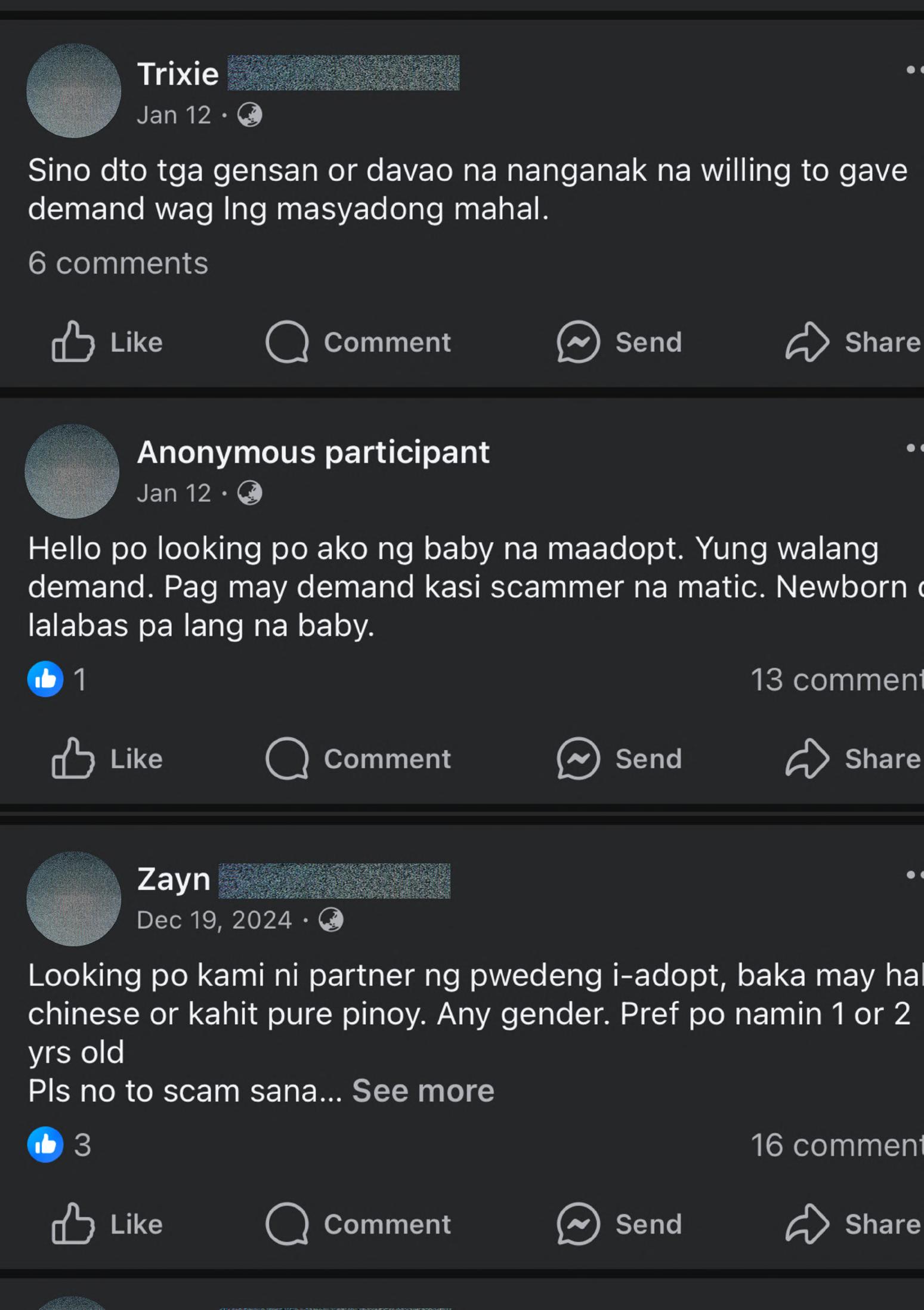
The danger of losing control—a story of a gambling queen

TBy BWAN LILA AGUHAR and SHATASHA ANNE F. BAILEY
he glitz and glamor of casinos draw people in like moths to a flame.

Some relish in the feeling of the light. Some end up getting burnt to a crisp.
Meet Luisita “Tita Babes” Caringal, a 70-year-old resident of Las Piñas City. She is a woman who has experienced both the highs and lows that come with gambling.
"Nang manalo ako, 70,000 ibinagsak ko d'yan. Ang pinanalo ko is 1.170 million (When I won, I put down 70,000. I won 1.170 million)," she recalled. It was November 23, 2022. She remembers this day as one of her biggest wins.
However, she warned that the highs can be addicting.
“One time, habang nagchi-chika, biglang nanalo ako ng 7,000 sa Scatter (One time, while talking with my friends, I suddenly won 7,000 playing Scatter),” she says. Scatter is a popular online betting game in the Philippines.
Tita Babes admits that gambling can easily become a trap, especially for those who do not have the means for it. She does not encourage gambling as a way of life. "Huwag gawing parang negosyo ‘yan (Don’t make it a business). It's not nice," she warns. She considers herself fortunate to have financial stability, but she knows that many people do not.
“If you don’t have money to do that, don’t. If you have only a bit of money, kakainin mo na lang, ilalaro mo pa? Huwag (If you only have a little money, would you rather eat it or gamble it? Don’t),” she advises. "Lalo kang kakainin niyan (It will consume you even more)."
For her, gambling is a pastime, not a necessity. “Kaya ko lang ito ginagawa kasi wala na akong ibang ginagawa. Nakapagpatapos na ako ng mga anak ko (I only do this because I have nothing else to do. I’ve already put my children through school),” she explains. She finds herself alone a lot as her children have settled abroad and her only grandchild is always busy with school. Sometimes, she uses the time she has on her hands to head to the casino.
One of the biggest hurdles that you have to get over in gambling is knowing when to stop. “Katulad kagabi, naka-4,000 na ako sa Scatter.
Hindi ko na napigilan (Like last night, I won 4,000 because of Scatter. I couldn’t stop myself from betting),” she admits. Even for someone with experience, the lure of the game is strong. “Nakaka-addict. Like, ayaw mo na pero sige, okay lang (It’s addictive. Like, you want to stop, but you still go on, thinking it's fine).”
Tita Babes is aware that her lifestyle is not for everyone. “Ako, nagpapasarap na lang sa buhay. Pag wala akong magawa, casino (Me, I’m just enjoying life. When I have nothing to do, I go to the casino),” she says with a laugh. Unlike others who gamble out of desperation, she insists that she plays for enjoyment, not out of financial need.
The Final Bet Tita Babes made sure to leave a piece of advice for those who are looking to pour money into gambling. "Huwag mong isusugal lahat ng pinaghirapan mo (Don’t gamble away everything you’ve worked hard for)."
Gambling is a game for Tita Babes. However, her advice for everyone is that in gambling, just like in life, it is always wise to know when to walk away.


Art by MARYCAR MITZI O. CRISTOBAL


By BWAN LILA AGUHAR
Wearing only a longsleeved shirt, shorts, and flip-flops, Ben Paragas (Kuya Ben), 42, steps onto his boat and ventures off across the waters of Manila Bay. He casts his net over the side of the boat, watching it spread out and sink beneath the surface of the water. Today, he figures this harvest will scrape in enough money to sustain himself and his family—but will he be lucky enough tomorrow?
Kuya Ben returns to the coast he calls home. His wife Nelia, 43, and his son Jiboy, 14, help him clean his haul. They sell them for 80 pesos per kilogram on the sidewalks of Zapote market in downtown Las Piñas. They earn about 700 to 800 pesos a day, and it is barely enough to sustain the needs of their family.
Kuya Ben’s family has always relied on fishing as a source of income, like many others in the area. The sea has always provided, and every day, they manage to march on unbroken. Every morning, his wife helps sort the catch, while his eldest son delivers orders to local markets.
On good days, they earn enough to cover the expenses that come with their food, boat maintenance, and their children’s education. On bad days, they barely break even.
This source of income could slip from their grasp when hundreds of hectares of land is reclaimed from the shore of Manila Bay. This goes the same for the nearby villages in Las Piñas and Parañaque where at least
3,000 fisherfolk live.
On October 2024, Las Piñas City Councilor and congressional candidate Mark Anthony Santos asked the Department of Environment and Natural Resources (DENR) to proceed with the much-delayed P103.8 billion Las Piñas-Paranaque Coastal Bay Reclamation Project.
The project covers around 530 hectares hectares of land of the Manila Bay coastline in Las Piñas and Parañaque.
Kuya Ben gestures towards the sea and points into the horizon. “Dati ang dami naming nahuhuling isda. Banye-banyera. Ngayon halos wala na. Ayaw na ng mga isda dito. Palayo kami ng palayo, kasi lumalayo ang mga isda. (We used to catch a lot of fish before—barrels and
fish don’t want to be here anymore. We have to go farther and farther because the fish keep moving away),” he said.
Boats need to travel longer distances and burn more fuel clinging onto the hope that they’ll garner in a bountiful harvest. When they are dogged by misfortune and end up bringing home produce that is not up to standard, both the fishermen and the consumers have to suffer because of the price hike.
Soon, the waters will be too shallow to cross, and the life that it once teemed with will be gone. It is due to reclamation projects that fish populations continue to decline. Their very existence is threatened by the pollution and habitat destruction that comes with reclamations. Those that are spared move far away in search of other habitable waters. They stray further away from the reach of fishermen in need.
From Cagayan to as far as South Cotabato, at least 239 reclamation projects are in various stages of development. If combined, these land expansions would cover a whopping 54,660 hectares. This is a landmass almost as large as Metro Manila itself.
These projects are for commercial ventures: condominiums, glitzy casinos, massive complexes, and sprawling shopping malls. The bay is slowly being turned into real estate, piece by piece.
‘‘ Kung tatabunan ng tatabunan ng lupa ang dagat, san na kami mangingisda? Hindi naman lalangoy ang isda sa semento.
25
million Filipinos are at risk of displacement and livelihood loss reclamation projects in the Philippines
Source: PSA, PRA, & ALTERMIDYA bythenumbers.
Investments Corp. hold stakes in these ventures. Their influence fortifies policies that favor profit over people.
Some of these projects are mounted as a necessity for national infrastructure. Expressways, railways, and ports like the New Manila International Airport, Sangley Airport, and LRT-1 Extension Project are all part of the administration’s "Build




In 2022, President Ferdinand Marcos Jr. ordered an indefinite suspension of 22 major reclamation projects in Manila Bay following backlash from environmental groups. However, beneath the surface, approvals continue to move forward. The Philippine Reclamation Authority (PRA) still grants permits behind closed doors. This has become the reason people are raising concerns about transparency. People are left wondering—who is truly watching over the bay?
The erosion of marine livelihoods is not an inevitable consequence of progress. It is something that can be avoided through proper resource management. This, hand-inhand with the implementation of policies that take the economy and the environment into account, would steer our country clear off the path of impoverishment.


There are at least 239 reclamation projects in the Philippines. This is
The fisherfolk of Manila Bay have long been the stewards of the sea. Their lives have been intertwined with its rhythms. The cost of progress will be paid in a coastline stripped of its soul.
When the time comes for the tide to turn, will it be in favor of those who build, or those who fish?
Source: THE DAILY TRIBUNE bythenumbers.
54,660 hectares of land in total. It is as big as the entirety of Metro Manila.
103.6 billion pesos is the budget for the Las Piñas-Parañaque Coastal Bay Reclamation project.
Source: EARTH JOURNALISM NETWORK bythenumbers.

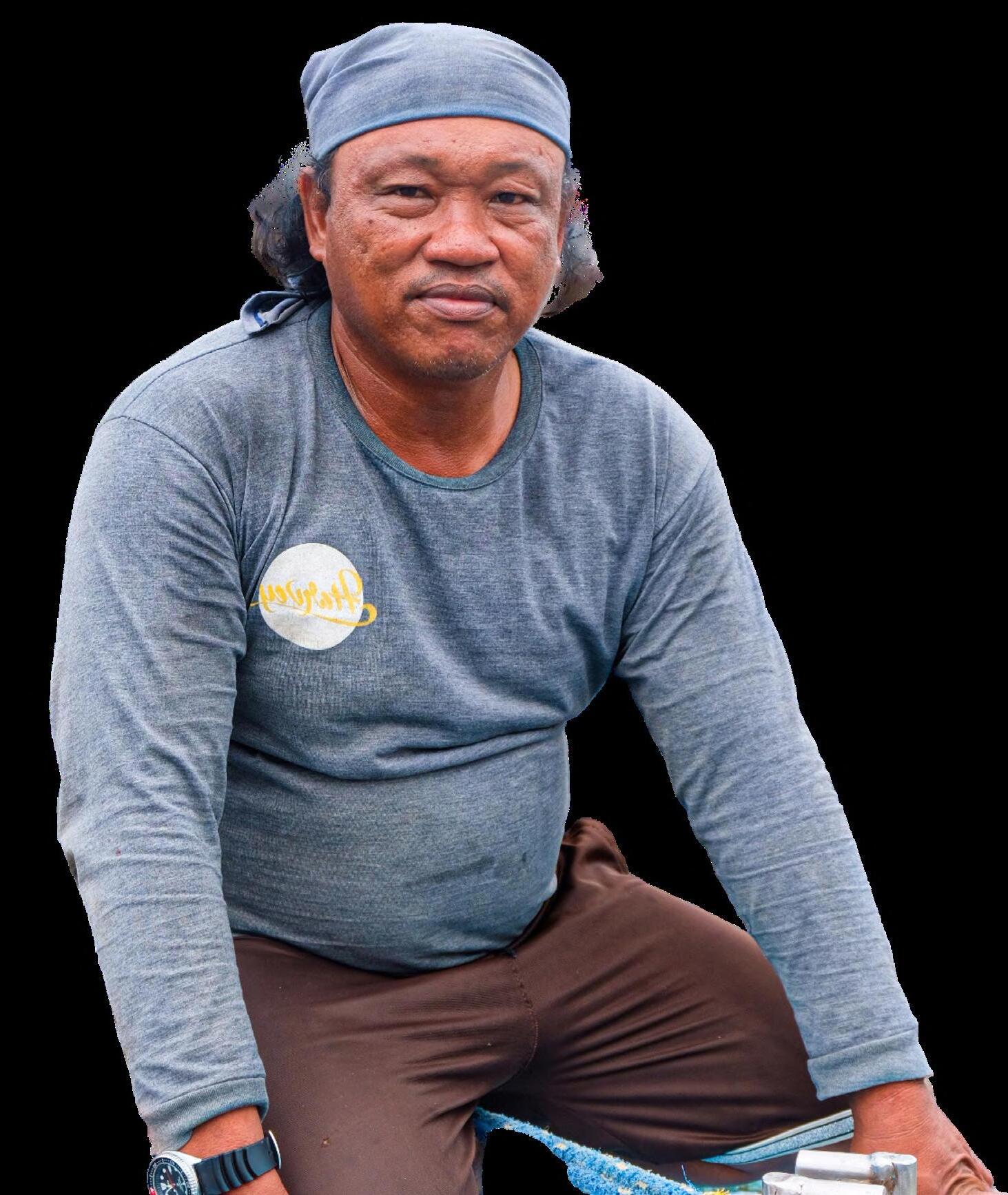
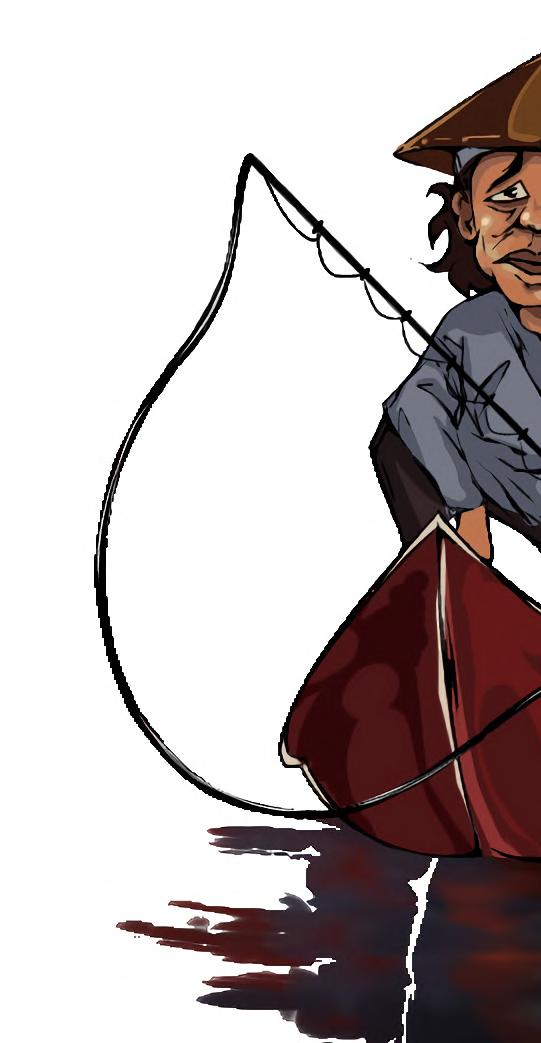


Art by MARYCAR MITZI O. CRISTOBAL
AGAINST THE TIDE. Ben Paragas, a seasoned fisherman from Las Piñas, continues to work hard despite the heat of the sun beating down on him. Photo by BWAN LILA AGUHAR





By
For the common folk, a boat is just a vessel for transportation or fishing. But for Ronalyn "Egray" Sacupon, 10 years old, it is home. Her days are spent on the open water with no land to anchor to. Every day, her survival depends on the sea’s
fishermen and residents community amidReclamation
Egray’s family was previously relocated to Cavite due to a reclamation project. Her father, a fisherman, tried to adapt to life on land, but they struggled to make
“Wala pong ibang trabaho si Tatay kundi pangingisda. Doon sa Cavite, wala kaming hanapbuhay, kaya bumalik po kami dito (My father has no other job except fishing. In Cavite, we had no livelihood, so we decided to return here),” Egray shared in an interview with The Standard Press. Rather than continue to suffer inland, they decided to return to the water, where fishing was more accessible. However, life in a floating house comes with its challenges.
“Minsan po, mahirap kasi pag malakas ang ulan o hangin, parang sumasayaw po ang bahay namin (Sometimes it’s hard because when it rains or the wind is strong, it feels like our house is dancing),” she said. “Pero sanay na rin po kami. Mas gusto po namin dito kasi malapit si Tatay sa dagat. (But we’re used to it. We prefer it here because father is close to the sea.)” Despite the instability
of their living conditions, Egray finds happiness in the presence of her family.
Reclamation projects come at an expensive cost. The fishermen and informal settlers are left without support or compensation despite how much these projects affect them. Many have to look toward relocating to unfamiliar areas where jobs are scarce. This leads to increased poverty.
The proposed reclamation projects involve converting seas into land for commercial and infrastructure purposes. It comes at the expense of coastal communities that rely on water-based locations. These projects displace families living along shorelines. This includes fishermen who rely on the sea for survival. Despite living all their lives relying on the sustenance that these bodies of water provide, these reclamation projects have previously forced families to relocate to areas where they struggle to find stable employment.
Egray’s Wish
As more land is reclaimed for commercial and industrial use, it is imperative to consider those who will be displaced. Communities like Egray’s need sustainable alternatives—housing solutions that allow them to stay close to their source of livelihood while providing stable shelter.
development does not come at the cost of human lives and dignity. Otherwise, the sea that once provided life for these communities may become the waves that push them farther away from the shore.


makapag-aral ulit para makapaggrade 5 ako. Kaya lang, mahirap po (I really want to study again so I can reach Grade 5. But it’s difficult),” she said, a hint of sadness in her voice. “Yung mama ko po, iniwan na kami nung naghiwalay sila ni papa. Mahirap po mag-aral pag walang mama. Kaya tumutulong nalang po akong mangisda. (My mother left us when she and my father separated. It’s hard to study without a mother. So I just help fish.)”
‘‘ Ang wish ko po, magkaroon kami ng bahay. Mahirap po tumira dito. Sana po mabigyan kami ng bahay ni Lord.
Nanay Morita Dela Cruz, 64, stands behind her small cart as the chatter of vendors fill the air and the scent of freshly cooked street food lingers in the streets of Las Piñas. She sells the freshly caught fish from their family’s harvest earlier that morning to passersby. She has relied on this modest livelihood to support her family for years. But today, her biggest problem is not making ends meet—it is keeping her home above water.
Nanay Morita’s house has been suffering from constant flooding. It has now become a regular occurrence.
The culprit? Large-scale reclamation projects along Manila Bay. These projects alter the natural water flow and cause excess water to back up into residential areas.
“Dati, oo, may baha, pero mabilis humupa. Ngayon, konting ulan may tubig na sa loob ng bahay (Before, yes, there was flooding, but it would subside quickly. Now, even with only a
little rain, water gets inside the house),” she shares. The frustration in her voice was evident.
Wading Through Crisis
Selling fish on the street has never been easy, but the worsening floods have made it even harder. Fewer customers are willing to wade through flooded streets. This causes frequent disruptions to her routine, and Nanay Morita’s income takes a hit. Some days, she barely earns enough to buy food for her family.
“Kapag malakas ang ulan, wala halos bumibili ng mga paninda ko. Minsan kailangan ko pang huminto ng ilang araw dahil hindi ako makalabas (When the rain is strong, no one goes out to buy my produce. Sometimes, I have to stop selling for days because I can’t even leave the house),” she says.
The flooding in Nanay Morita’s neighborhood is not an isolated case. It is part of a larger crisis affecting thousands of families in coastal communities near Manila Bay. The government has approved numerous reclamation projects aimed at urban expansion and commercial development, but at what cost?
Presently, Las Piñas City Councilors Mark Anthony Santos and Henry Medina denied the claims of disastrous flooding, reassuring concerned citizens that there were no sufficiently established environmental threats present, especially with Alltech's aforementioned ecological compliance checkmarks from The Philippine Reclamation Authority and DENR.
‘‘


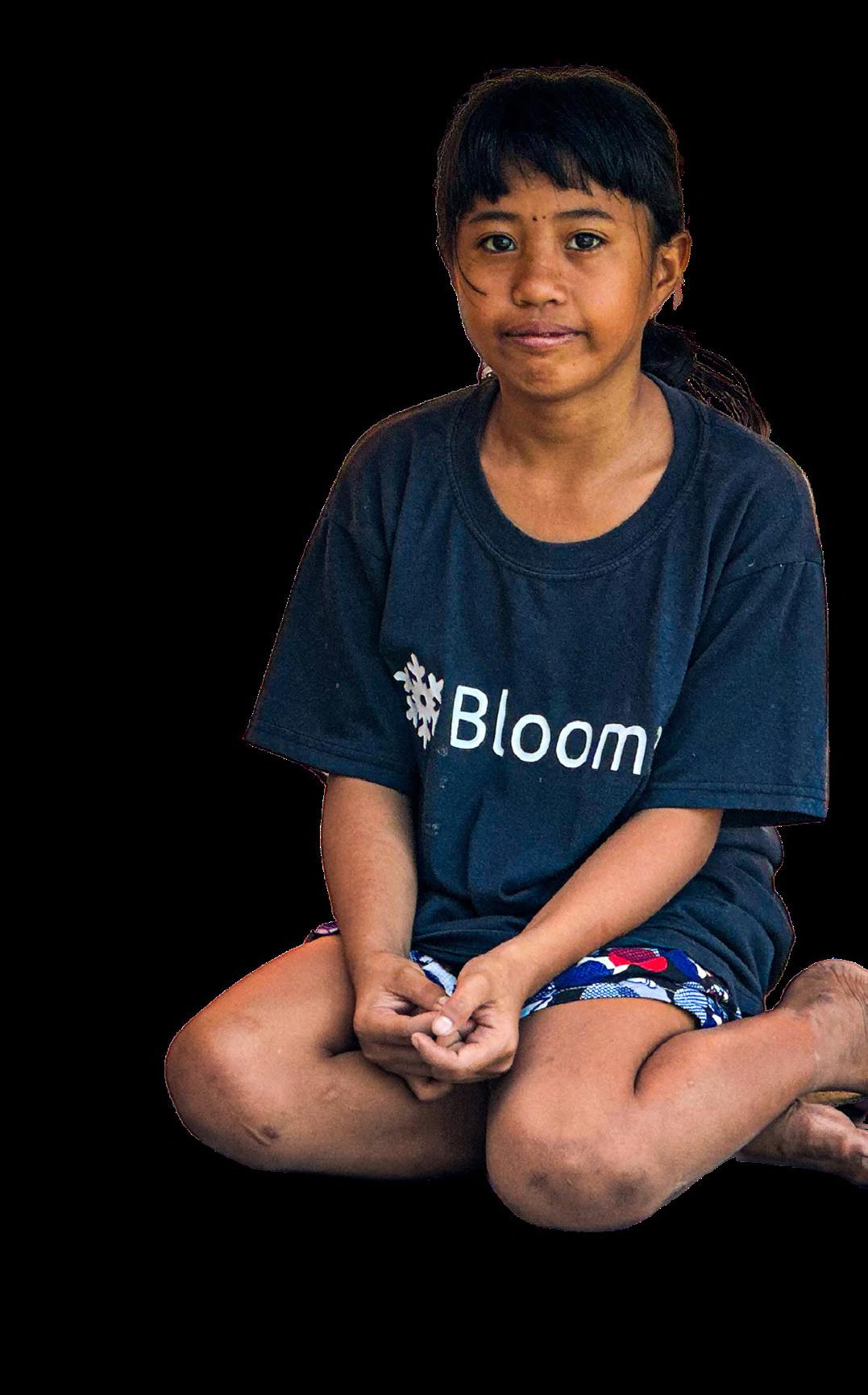
The Las Piñas-Parañaque Coastal Bay Reclamation project will affect the lives of
1.3 million residents
Source:
STATISTICS AUTHORITY

Even so, all 22 sub-branches of the reclamation project have been suspended because of the insistent back-and-forth banter between the two parties, awaiting approval from the presidential body. The Reclamation waits once more, but the problems surrounding it simply cannot.
Sana marinig kami. Hanggang kailan namin titiisin 'to?
Local officials have acknowledged the problem but offer little in terms of long-term solutions. Temporary drainage systems and relief efforts only provide short-term relief. The larger issue of land reclamation remains unaddressed.
Nanay Morita refuses to give up. She continues to work, to provide, and to hope that her community will not be forgotten.
Which side do we choose, correlating the project with the country's conceptual rise, or campaigning for it to be taken down centerfold? The answer? The truth. The harsh, blindingly bright reality that behind the curtain of drama and controversy, people are struggling.
As the people of today and the future of tomorrow, we are
presented with a choice: dip into the drama, filling our ears with a stripping, static grain, or see past the suspicion and set our sights on those most affected, the socio-economic states that threaten the very lives of our fellow Filipinos.
For Nanay Morita and many others in Las Piñas, the floods show the possibility of their dreams being pulled under the waters. Will their
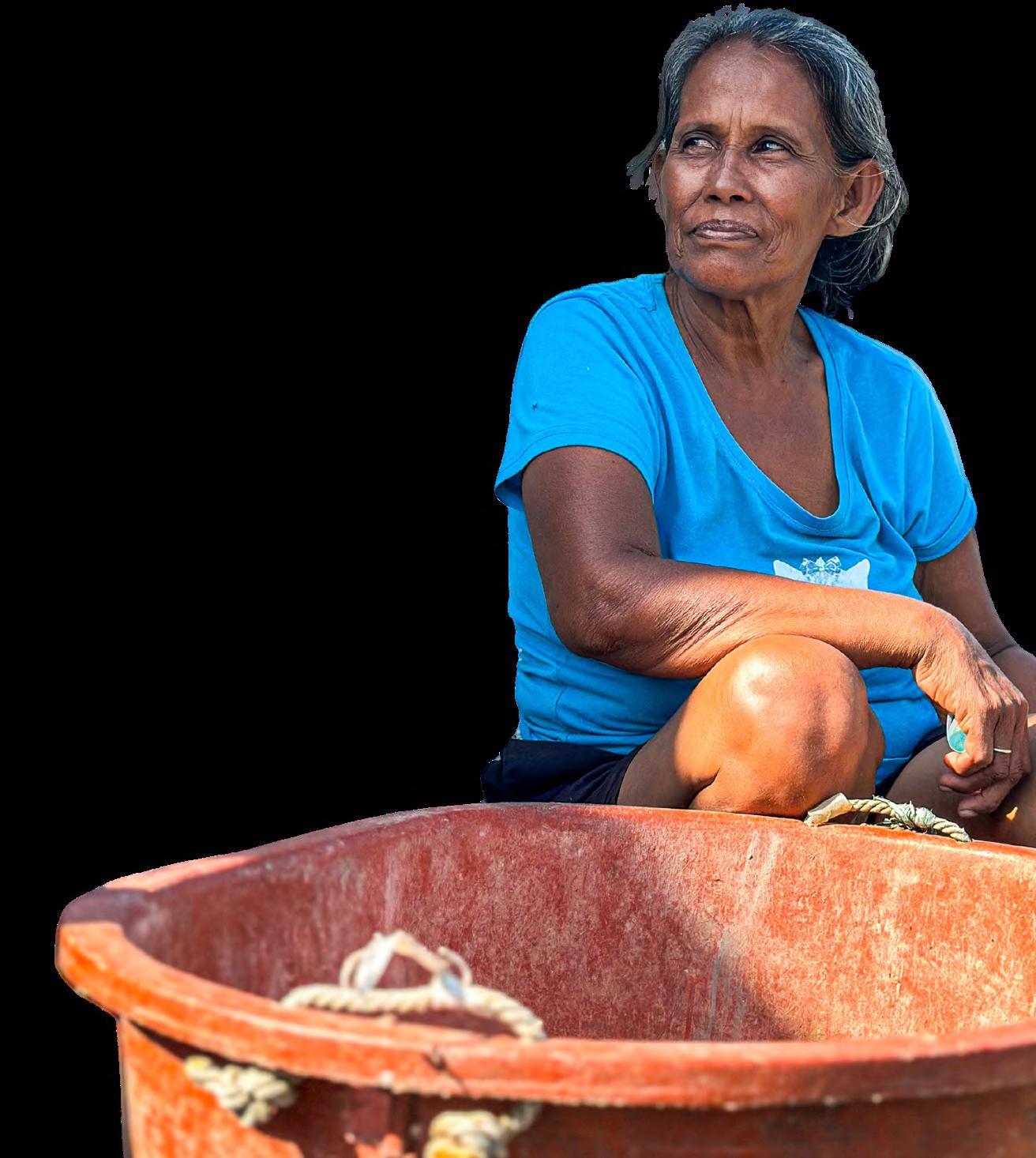


SATRIAH ARYAM C. MANSUL and BWAN LILA AGUHAR
feature.
ADRIFT BUT UNBROKEN.
Egray, just 10 years old, gazes out from her floating home.
Photo by BWAN LILA AGUHAR
localfeature.
PHILIPPINE
bythenumbers.


TStories of Hope
She Cancer-vive: ROUND 2
ARVIN JOSEF LYON P. PADILLA She survived
riumph can feel like a sealed chapter, a hardearned victory etched in time. But what happens when a glorious triumph from our past is unexpectedly snatched away from us, forcing us to relive the agonizing battle for a second time? With a quick jab from a seemingly defeated foe, Ms. Shenandoah Tejada Kwek, a teacher from Las Piñas City National Science High School, returns to the
battlefield to face a oncedefeated adversary.
"My mind finds it difficult to process that it came back; we never expected it. After all these years, we thought the recovery would continue, and then all of a sudden, it returned," Ms. Shen lamented. When she found out that the cancer – now in its final stages – that many believed she had already beaten had returned, anxiety and despair consumed her.
"Since I’ve already experienced the treatment before, I know that I could handle it, but my problem is when my doctor told us the treatment plan, she revealed that immunotherapy costs 350,000 per session, and I need to have 25 sessions of it," she admitted. When asked about her biggest worries when she found out about the cancer’s return, money and resources were her sure answer. Despite her and her husband working, it still proves to be insufficient in covering the expenses of her treatment.
Aside from the expenses that come with her treatment plan, Ms. Shen also struggles immensely with her mental health, which eventually manifested physically, taking a toll on her body. Immense hunger, vomiting, and pain torment her during each session of her treatment, which she believes are amplified by her anxiety.
"The school is generous enough to allow me not to teach this year, which is something I'm extremely grateful for," Ms. Shen expressed her gratitude. Considering her anxiety and deteriorating mental health due to her illness, her doctor advised her to continue working and being at school.
"I've been diagnosed with Acute Anxiety Disorder since starting my treatment, and working is my way to relieve stress," Ms. Shen revealed. In addition to needing the income from her salary as a teacher, Ms. Shen explained that socializing with her
Family Above All
LESSONS OF COURAGE. Ms. Shen, a devoted teacher, continues to push through while bravely fighting her battle with cancer. Photo by ARVIN JOSEF LYON P. PADILLA
Ms. Shen is a mother before she is a teacher, and explaining her condition to her young son Cross proved to be an emotional rollercoaster.
"He knows that mommy is sick, he understands that already,

and I think he's matured because of it since he has to take care of me," Ms. Shen explained. When Ms. Shen told her son about the possibilities that might arise from her disease, it was as if a sense of maturity ignited within him. "I don't want you to die, mommy," is something Cross says that continues to echo in her mind. Despite his young age, her son goes above and beyond to be there for his mother at all times.

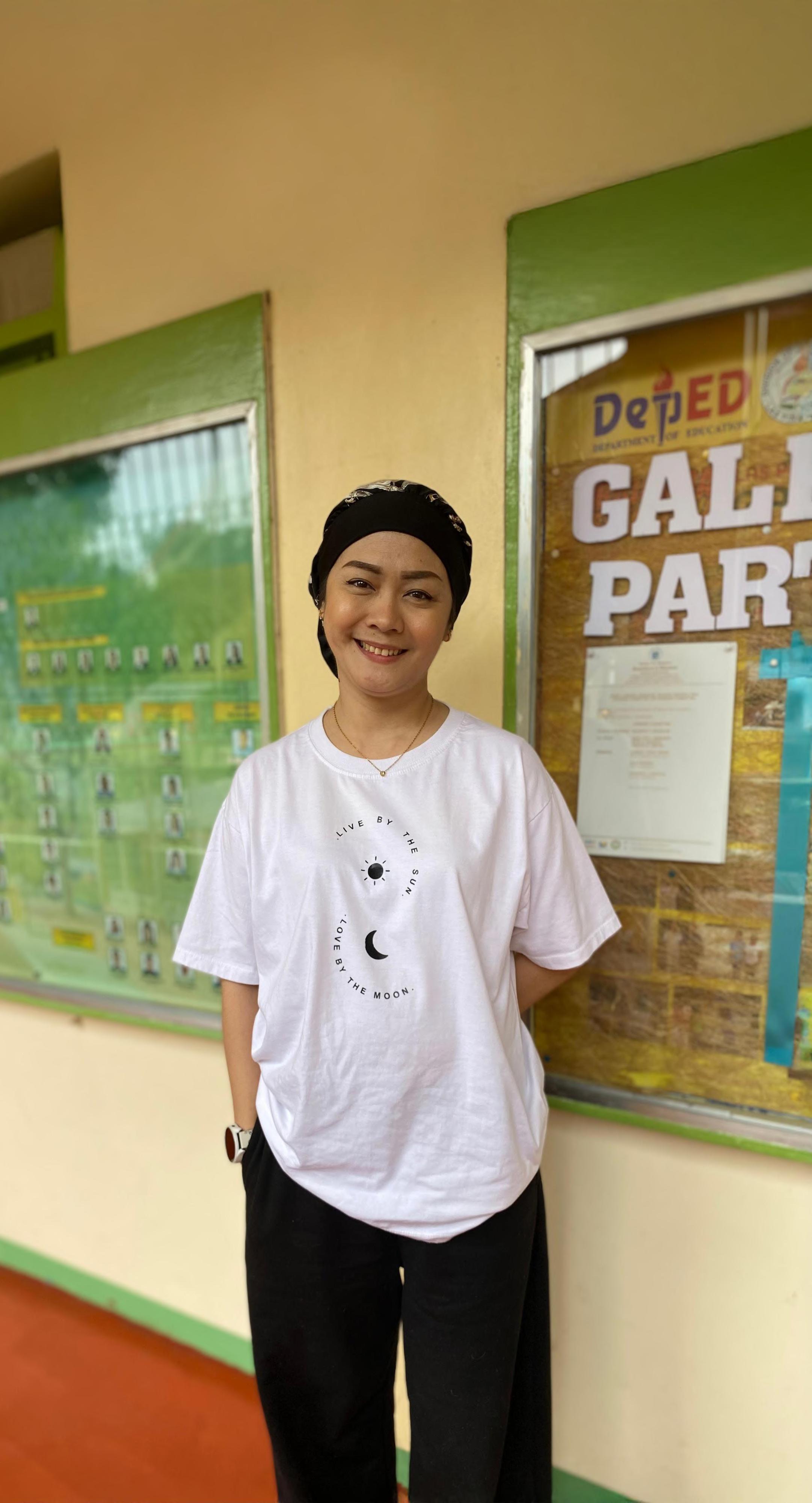

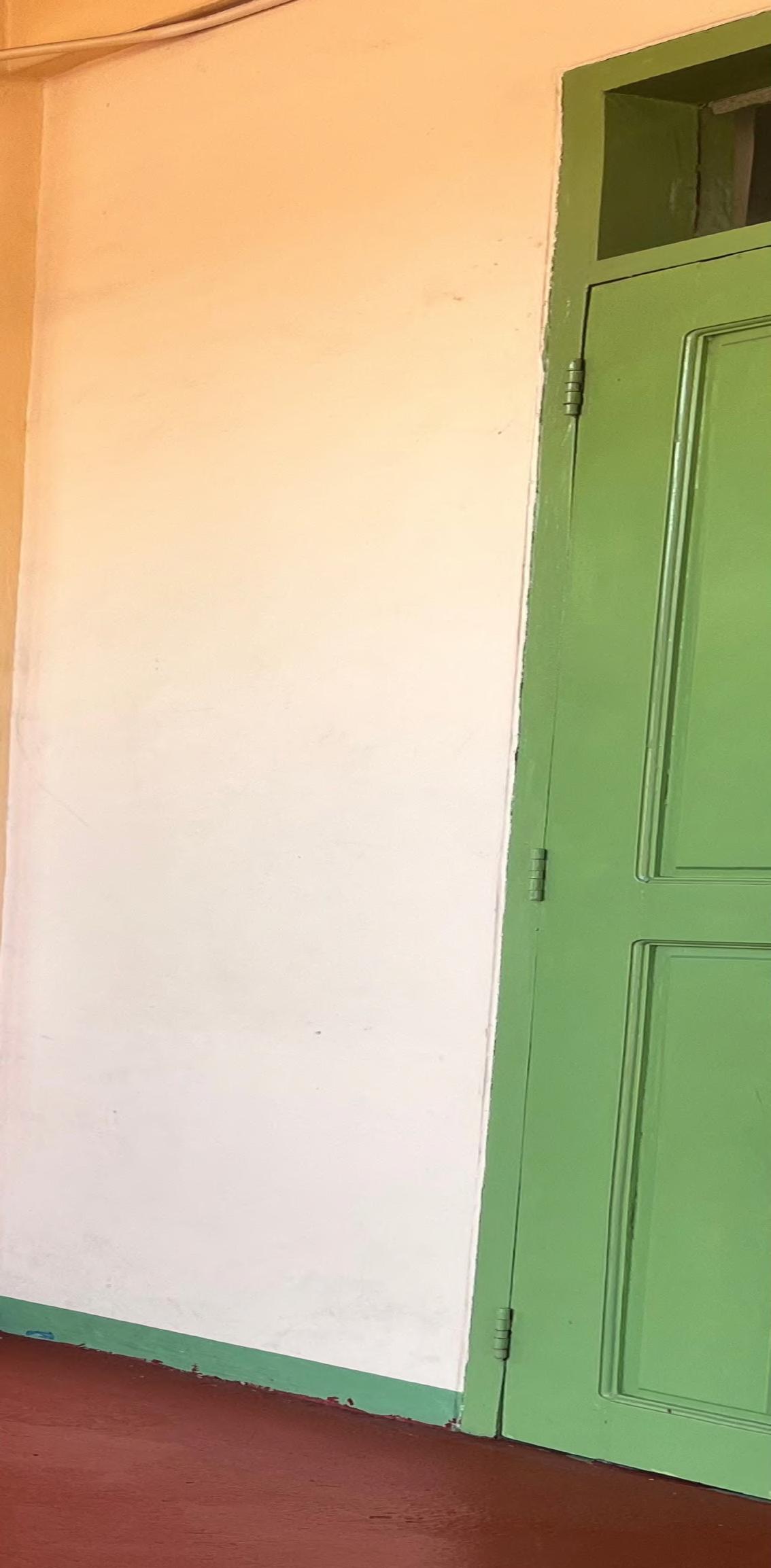

Ms. Shen also recalls the crucial role her husband plays in her recovery. "My husband is the best support, my rock," she conveyed. She remains grateful that her husband continues to hold her hand despite all of the challenges that come with the disease, and that he does all in his power to make sure that they have the means to proceed with her recovery.
“It’s okay to not be okay; it’s okay not to be brave all the time. I try to be brave for my family, but sometimes it's too much," she voiced with heartfelt conviction. Ms. Shen believes that we must not force ourselves to be okay all the time, and that sometimes, it truly is healthier for us to admit weakness and embrace vulnerability.
By ALEXA M. LORENA and BWAN LILA AGUHAR



Amid the already struggling Philippine economy, who would have thought another unsettling story would emerge? POGO, in its common term, stands for Philippine Offshore Gaming Operators — an industry that has built itself on discreet but highly lucrative, legal gambling operations and only a few had the courage to unveil the sinister stories wrapping its reputation. Like someone searching for truth in the darkness, one man shone a light on the unknown—Daveine Dolon, a former POGO employee.
“Noong 2023, may lumapit sa ’kin, sabi n’ya may magandang trabaho sa isang kumpanya dito sa Las Pinas.” Daveine started his narrative. “Customer service sa online games. Libre daw ang pagkain, tirahan at malaki ang sahod — 20k starting kaya tinanggap ko agad.” He explained. For someone like Daveine, new to the field, the job offer was already enticing, making it hard to refuse.
Like in a typical horror film, little did he know that the moment he set
"Know that there are genuine people who are willing to help you, there are people willing to carry the cross for you," she expressed. In the battles that we continue to fight on a daily basis, no matter how big or how small, it is important to remember that we do not have to be alone.
Inspiring Initiatives
"Shen Can is a Facebook page created by my former co-teachers and friends to raise funds for my immunotherapy, chemotherapy, and everything that I need for my treatment. I am really grateful for those people who helped me," she expressed with immense gratitude.
With constant updates regarding her condition and unwavering determination to help Ms. Shen on her journey, the Shen Can page continues to raise awareness to reach out to the generous hearts who are able to join her in the battle she continues to fight. You can send your donations via GCash to Shen Kwek (09173017462) or Budj Kwek (09983360385).
Since finding out last July of

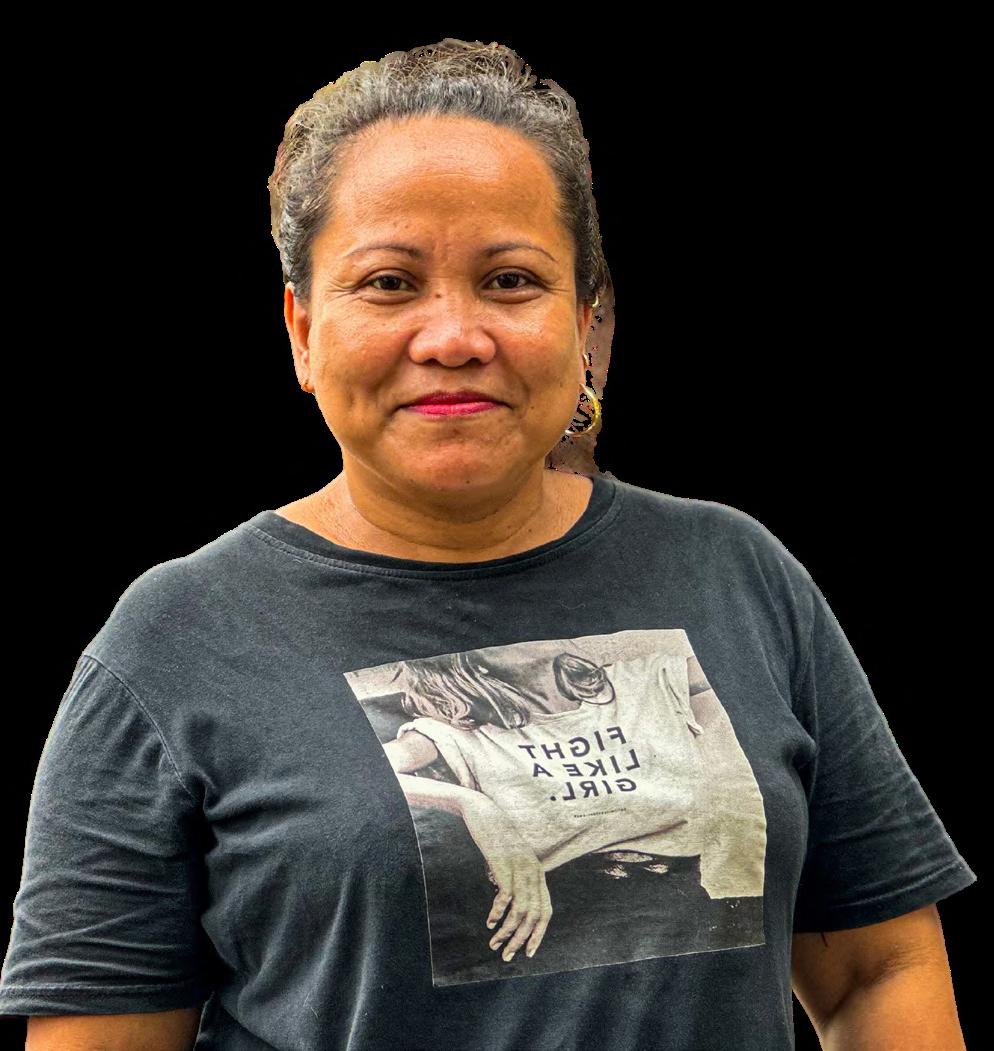
Rina De Isidro sat silently, her head hung low in the restaurant's leather booth chairs. She stared at the menu of dishes resting on the table, unable to comprehend the words printed on the paper. Her eyes never dared to meet the other customers, pangs of shame gnawing at her at the thought of them seeing her struggle with something that was supposed to be elementary.

Rina, or “Ate Rina” as people fondly call her, was parented by a single mother after her father passed away when she was five years old. She had only finished second grade, and while she was familiar with a few letters, she never formally learned how to read. As time went on, she gradually began to self-study but admitted she was still quite slow. At the age of 40, she still had difficulties reading. "It was easier to hide that I didn't know how to read than asking for other's help." she would say. "It was because I was ashamed."
How could a person fall into such a predicament? The answer: slipping on a few cracks in our country’s foundations—our education system.
lagging one to three years behind their current grade, unable to juggle catching up to what they’ve missed and keeping up with what they’ve been learning. The 2024 PISA scores and the evident proofs scattered around every academy and college say enough—we need to set things straight, and fast.
Ate Rina's story isn't just a mark on the country's growing list of people they've failed. It's a window to acknowledge the worsening state of Philippine schools, the second home for the future of the nation, and the problems that surround it.


foot in the workplace, unease would begin to creep in. “Sa una, akala ko totoong customer service lang talaga, ‘yon pala sugal sa online.” Daveine came slowly to his realizations.
The Rising Ordeal
In recent years, POGO has exponentially grown in the Philippines, particularly during the pandemic. These companies have built exclusive communities within Metro Manila and even in high-end areas of Cavite. These operations certainly caused a rise economically with estimated total benefits amounting to P166.49 billion annually (Philstar.com) but what happens behind all of these?
Along with other 2,714 workers of different nationalities, some including 528 Filipinos, 600 Chinese, 183 Vietnamese, and 137 Indonesians, allegedly forced to work (Philippine News Agency), the POGO employees were tasked to sit while being provided a monitor carefully operated for each one of them.
This entire POGO fiasco is organized crime, with each
transaction carefully planned and executed to avoid detection. Whispers of threats followed those who attempted to escape through dark alleyways in the dead of night, creating a perfectly horrifying pattern of human trafficking and exploitation.
Riding the Raid
When asked about the raid, Daviene said he was lucky he wasn’t there that day. “Noong araw na yon nataong day off ko kaya wala ako doon. Swerte siguro matatawag. Pero sabi ng mga kasamahan ko bigla na lang may pumasok na mga pulis na kala nila sibilyan lang, yun pala mga pulis at NBI agents. Wala na silang nagawa.” He explained. The workers were rescued during the raid by joint operatives from the NCRPO and the Philippine National Police-Anti Cybercrime Group (PNP-ACG) at the POGO establishment Alabang-Zapote Road in Barangay Almanza Uno.
The operation to uncover the alarming reality behind POGOs followed, with search warrants issued by a local Las Piñas court to legally search the hub and track down the perpetrators.
The Second Congressional Committee on Education (EdCom 2) offers us a few insights. According to EdCom 2 Executive Director Karol Mark Yee, the Philippines faces more than just a deficit in literacy and numeracy. We're talking about a 5.5-year age-learning gap in Filipino students, along with the grim reality of our establishments and students.
Filipino students lack basic yet crucial concepts in English, Science, and Math.
Amid the struggles of nonliteracy, Ate Rina pushes forward. This is because she aspires to keep her children, both in senior high, rooted in a steady, steadfast, and fundamental education, in hopes of giving them the future she wished she could have had. She and so many others like her serve as a reflection of perseverance and a call for reform in the Philippines' core learning establishments.
What future is in store for our non-readers? Well, for those like Ate Rina, who strive to press on amid life's challenges and secure a fruitful fate for the next generation, the legacy she leaves behind is one for the books. That’s for sure.
Until then, we have some foundations that need fixing.

sahod kung mapapahamak ka naman.” As though he finally witnessed broad daylight again, Daviene expressed his hard-learned lessons with a breath of relief.
“Nakahanap ako ng matinong trabaho. Nagla-lalamove ako at nag-oonline selling. Mahirap, pero babangon ulit.”
that it is not all about the monetary advantages if it puts little to no regard to safety. After all, this is all a past nightmare that Daviene is thankful to wake up from. Indeed, no matter how scary a path is, it takes bravery to light a match hot enough to burn down the shiny facades covering the forbidding truths behind too good to be true opportunities.

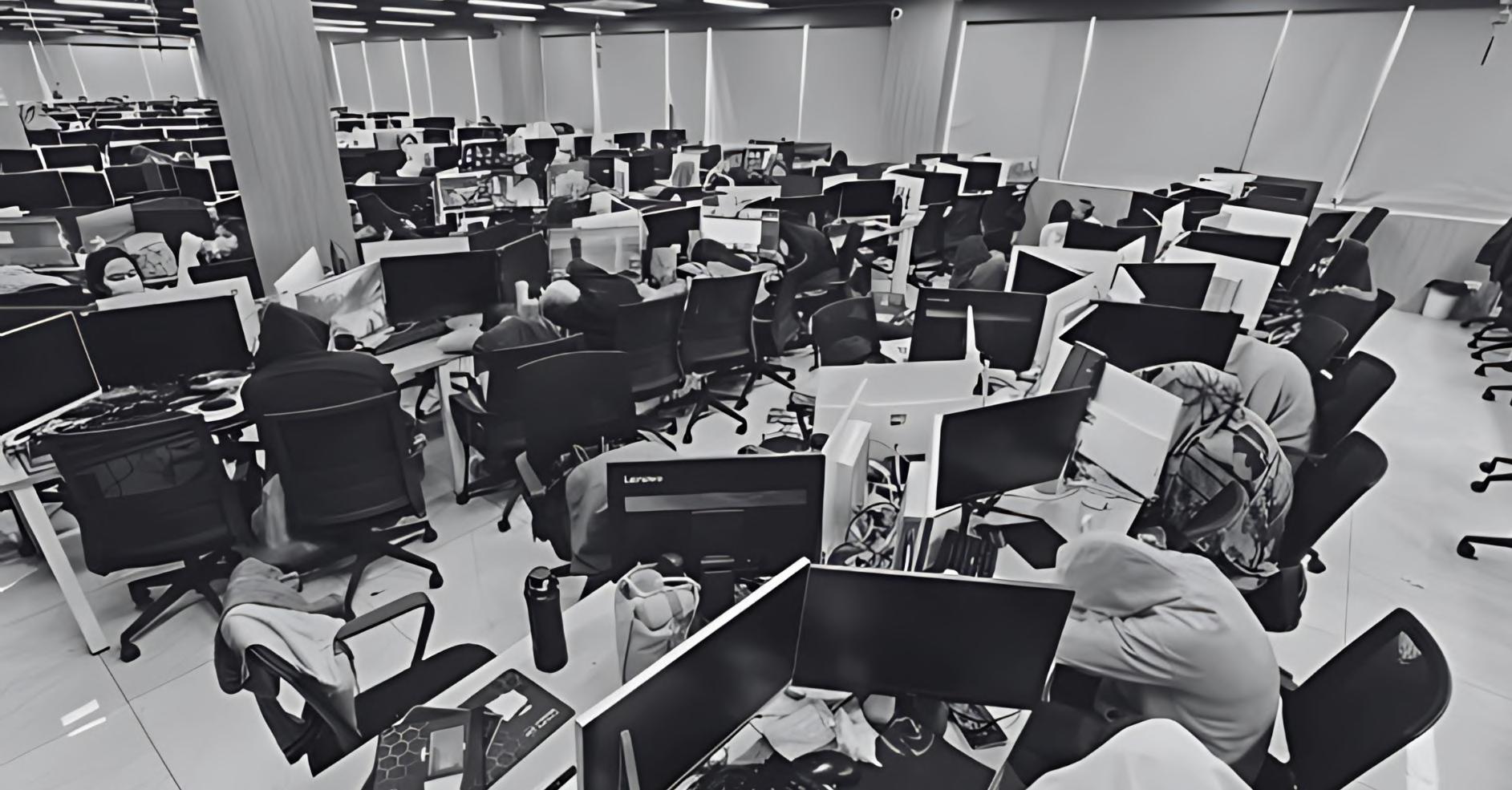

Daveine Dolon, once
caught in the peril of his POGO job, has now left behind his troubled past for a fresh start.
BWAN LILA AGUHAR
LEARNING KNOWS NO AGE. Rina De Isidro, who only learned to read at 40, shows that the pursuit of knowledge knows no bounds.
Photo by BWAN LILA AGUHAR



AI’NT GONNA TAKE THE THRONE
By TRISHA KATE S. MIGUEL
For centuries, humans have sought to create perfection, turning the unimaginable into reality. From the wheel to electricity, and now AI—who knew the human brain could invent such precision? Yet, the pursuit of perfection often leads to downfall. Sometimes, the biggest enemy isn’t the creator but the creation itself. Artificial intelligence (AI) has become a symbol of limitless potential, offering what seems like infinite knowledge. But when the computers crash, the cables tangle, and the systems fail, will AI still reign supreme? Or will the human mind continue to take the throne?
The Birth from Wires, Cables and Cords
The true mystery is where AI originated—and how it has become so unnervingly human-like. While technology has been around for decades, the AI revolution took a significant step forward in 1997 with Deep Blue, a chessplaying computer that famously defeated world champion Garry Kasparov. This technology was far from today’s AI, but it sparked fears that machines might surpass human intellect.
The New Wave
A decade ago, that fear became more tangible. Neural networks were introduced and advanced through deep learning, a technique allowing computers to master skills through practice. Thanks to deep learning, computers began to rival humans in various tasks. Yet, despite their capabilities, these machines remain remarkably easy to deceive. One famous example involves AI misreading a stop sign covered in stickers as “Speed Limit 80.” Their intelligence may be undeniable, but how reliable is it if a few misplaced stickers can trick them?
The Gen-AI-tional Era
Institute in New Mexico. “We’re beyond the deep-learning revolution of the 2010s, and we’re now in the era of generative AI of the 2020s.”
Generative AI (Gen-AI) refers to systems that can produce text, images, and other content—essentially mimicking human creativity. Many of these abilities stem from large language models (LLMs) like ChatGPT.
LLMs are called “large” because they are trained on massive datasets, including books, research papers, and online sources. However, it would be misleading to say AI “studies everything on the internet”; rather, it processes patterns from vast amounts of data. This is why AI can generate content across various fields, from art to mathematics.
Tied n’ Twisted Twins
Despite its advancements, AI has limitations. Humans have grown more dependent on this technology, yet dependence does not necessarily mean
Who’s the Winner? Who’s the Reject?
While AI may seem all-knowing, it still falls short of true human understanding. Meanwhile, human intelligence, though adaptable, will never achieve AI’s sheer processing power. Both have strengths and weaknesses.
Humans, by nature, strive for unrealistic levels of control and intelligence—whether through technology or their own mental capacities. No matter how powerful LLMs become, AI will never replace the first and greatest creation: the human mind. Unlike AI, the human mind is designed to think, to understand, and to live.
The real question isn’t whether AI will take over, but how humans will integrate it into society responsibly. With ethical development, regulatory frameworks, and an understanding of AI’s limits, we can ensure that artificial intelligence supports rather than competes with human intelligence.


Who knew that your best duo in a video game could be an AI robot? Researchers from the University of California, Berkeley, thought it would be a good idea to teach AI how to play Overcooked, a popular multiplayer video game where up to four players whip up chaos in the kitchen. In theory, it seemed like a good idea. But as tests went on, it began doing things the researchers did not
AI to do what it just did. Yes, it saw people placing dishes down and picking them up, but it seemed to figure out and connect everything it observed altogether. This action prompted its human partner to serve the food, helping them earn double points.
Admiration Galore


Everybody knows about the now-famous ChatGPT. But there’s a new competitor in town: iTanong, a Tagalog-based AI chatbot. Developed


Spawnpoint
Rohan Paleja and his team at the University of California, Berkeley, brainstormed, and— Eureka!—a brand-new AI model was born. Overcooked-AI began with four training methods. The first few stages focused on mimicking what human players do in the game. But here’s where it gets serious.
In the third phase, the AI was completely ordered to ignore all human data. Why would they do that, you may ask? Well, they terminated it because of what they had up their sleeves for phase four. Introducing the final stage: offline reinforcement learning (RL).
The Game Changer
When RL was implemented, Overcooked-AI was destined to take the world by storm. This is where the AI model truly learned how to play Overcooked. It watched human teams, but it didn’t just mimic their moves—it pieced together the best bits of what it saw. The AI stitched together every high-IQ move, strategy, and exploit. Basically, it learned everything in between— including hidden rules the game had that no player knew about.
Keep Up

When the AI wanted its human partner to deliver the food, it would place a dish on the counter near the human. Nothing out of the ordinary, right? Wrong. No one taught the

apart is its deep integration with Philippine-specific resources. It sources information from local databases, which ensures Filipinos receive relevant, context-aware responses.
Rohan Paleja shared how impressed he was with the model. Like Rohan, other AI developers can also build computer models that act like human tutors to teach AI. This study is an eye-opener for everyone. If a team from a university could make an AI play a game as well as humans do, what’s stopping AI from becoming human partners in kitchens, warehouses, and hospitals in the future?
AI is notably one of the fastestgrowing technologies in the 21st century. “[It] could be helpful in helping people reach their goals when they don’t know the best way to do this,” says Emma Brunskill, a computer scientist from Stanford University.
Game Over… Or Is It?
The attention Overcooked-AI garnered was certainly impressive, paving the way for more AI players to be created for other games, not just for Overcooked. This creation also opened conversations about how AI will be used in the long run. If it can master a simple video game, why not teach it to master fields such as healthcare?
The intelligence that Rohan’s team created is incredible—learning aspects that weren’t directly taught to it. Artificial intelligence that learns on its own, a technology that ensures victory over defeat, achieving the highest score and winning the trophy. This invention truly accomplished things its creators never expected it could do. That is what’s beautiful about it. It is so complex that even humans can’t fully grasp the strengths of their own creation.

by local researchers, iTanong could change the way Filipinos interact with technology.
New Kid on The Block
When OpenAI released ChatGPT in 2022,
researcher Elmer Peramo found the project familiar. He and his team at the Advanced Science and Technology Institute had been working on a similar chatbot, but funding and infrastructure challenges delayed their progress.
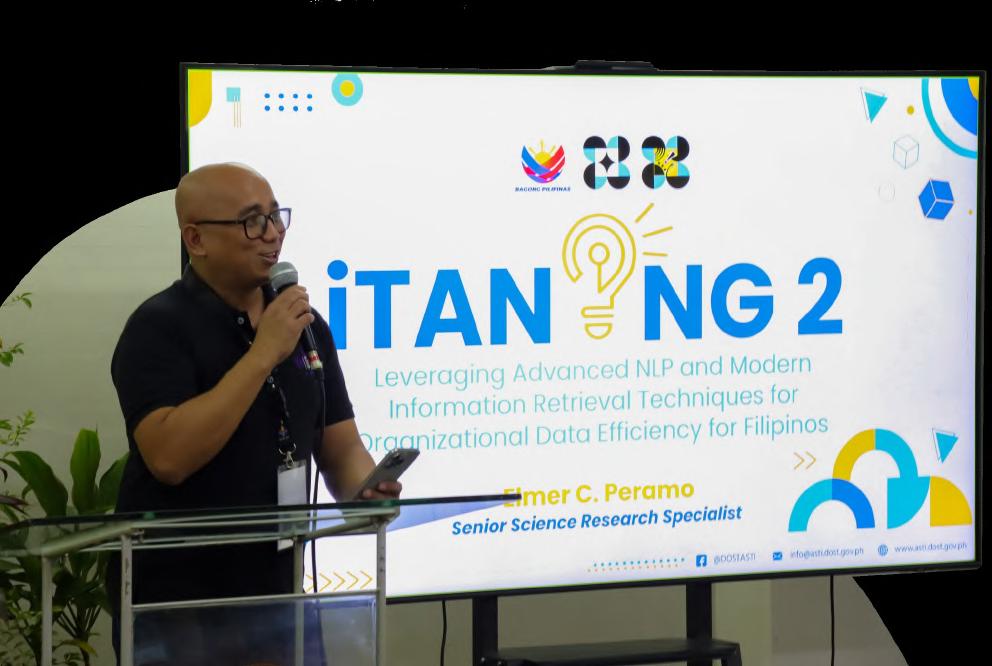
iTanong was created as a local version of ChatGPT, allowing users to ask questions in English or Filipino. Unlike ChatGPT, which relies on global datasets, iTanong integrates Philippine-specific resources, making it more useful for Filipinos seeking localized information.
Not Like Other Bots
Most AI chatbots, including ChatGPT, struggle with the Filipino language, often producing awkward translations and unnatural sentence structures.
“It still struggles with correct pronunciation, and I’m not sure it works well with our language,” said Bianca Aguilar, a product designer.
What sets iTanong
Your New Best Friend
Before iTanong becomes publicly available, it will first be deployed in government agencies as a digital Citizen’s Charter. Unlike the physical document updated annually, iTanong can be updated in real time, streamlining bureaucratic processes.”iTanong would be a godsend in helping with preemployment requirements,” Aguilar added.
The Broken String in The Code
Despite its advantages, iTanong faces challenges. AI chatbots struggle with minority languages, and Filipino is considered a low-resource language. Limited training data makes it difficult for AI to grasp Filipino grammar and dialects.
Peramo’s team uses open-source datasets like Common Crawl and Project Gutenberg but must also manually train the model to improve accuracy. However, this is slow and resource-intensive, delaying large-scale implementation.
Millions Missing Out on Great Technology
Even with iTanong’s potential, 20 million Filipinos remain internet-poor. “Those in rural areas face barriers such as limited connectivity, lack of education, and lower AI awareness,” said AI researcher Dominic Ligot.
Without access, many cannot benefit from AI advancements. While urban areas enjoy high-speed internet, rural communities struggle, raising concerns about digital inequality.
To bridge the digital divide, iTanong’s team hopes to provide internet access and tablets to underserved areas. They also plan to establish regional help centers for those unfamiliar with AI.
More than just a technological achievement, iTanong represents a commitment to empowering Filipinos. By prioritizing accessibility, it sets a new standard for local developers and may soon become an essential tool for the nation.
Art By JOSE YNIGO U. PANGILINAN


Period Bloodyour Health
By JOSHUA R. SACEDON
Diabetes is a frightening condition that causes severe damage to not only your eyes and kidneys but also to your nervous system and heart. A disease like that should come as a priority for diagnosis; however the only method to detect the disease is with blood sampling through the use of needles. This technique is quite tedious in nature, but what if there’s another way? A way that does not risk accuracy but also improves convenience? A way that does not prolong the process, but also revolutionize the scientific community?
In January, a health test that could analyze menstrual blood was approved by the U.S. Food and Drug Administration. This test is named Q-Pad, a sampling method that can detect a substance within period blood that could indicate the presence of diabetes. Sara Naseri, a cofounder of Qvin, the company that makes the Q-Pad, believes that this discovery may shed light on more opportunities.
WHAT IS PERIOD BLOOD?
Menstrual blood may seem to be similar to blood that runs through veins or arteries, but in actuality it is much more complex than that. One may think about how useful an organic byproduct that causes much pain can be more useful than being disposed of. Well, menstrual blood does have some uses. For starters, menstrual blood
or also technically known as menstrual effluent, refers to cells and tissues from the thickened lining of the uterus that is shed at the final phase of the menstrual cycle. Subsequently, it could be used for analyzing blood, as it does contain blood like others, with some difference being it contains proteins, hormones, and bacteria exclusive to the uterus. This fact makes knowledge about it limited, as Kathryn Clancy, an anthropologist who studies women’s health and medicine at the University of Illinois UrbanaChampaign, states that the research on this field of study is “so young that we’ve barely characterized everything that’s in it.”
In spite of the academic gaps, Naseri said that considering that 1.8 billion females menstruate globally, “Why let that go to waste?” With that Naseri had thought to look into the matter itself and investigate the mystery of menstrual blood. According to the findings gathered, there are indeed chemical markers of diabetes within menstrual blood. In addition, the hormones and antibodies that are present in it could also show signs of an individual’s vitality and current ailments.
Mechanics of Q-Pad
A single Q-Pad kit contains two menstrual pads that a user can wear to allow it to collect blood during the menstrual cycle. These pads will then be a substitute for analyzing the average blood sugar levels that hemoglobin A1c tests usually do with a difference of not
requiring blood draw. Moreover, Q-Pads can also be utilized to pinpoint polycystic ovary syndrome (PCOS), a condition that causes irregular periods and infertility.
IMPACT of Discovery
As of now, Q-Pads are only approved for diabetes, however, Naseri believes that they have more potential than they seem, as the proteins that it includes may indicate inflammation and the antibodies it has can detect the presence of COVID-19. Even with its great effects, Naseri states that there are more questions yet to be answered. These inquiries range from the build-up of substances to the preservation of samples, hence making the progress of developments slower. Another challenge was the preservation of the collected sample, as menstrual blood oxidizes as it is exposed to air.
With so many questions, one might ask whether or not the medical industry is doing its best to resolve these issues. Well, the problem is that discussions about menstruation are still yet to be unstigmatized by the community, making it a major hindrance in understanding the female body. That is why it is a must for us to make a change. It is a must for us to be open-minded when it comes to topics such as reproductive health, as not only would it pave the way for the development of new discoveries but it would also improve our view of health in general.



Why Does It Always Feel Like Los Angeles is on Fire?
By WALTER STANNIEL B. MORSIQUILLO
Los Angeles, the City of Angels, is once again giving its annual impression of Mordor. Five wildfires—led by the headliner Palisades Fire—are sweeping through L.A. County, turning paradise into a smoky barbecue. Surprisingly, it’s happening in January.
You might be wondering: “January? Isn’t that the time for existential dread, not wildfires?” Normally, yes. But thanks to climate change and some turbocharged winds, California’s fire season now operates with the flexibility of your worst groupmate—it only shows up whenever it feels like it.
How Do We Get a Fire Season in Winter?
Last year was wetter than an L.A. influencer caught in a rare rainstorm, leading to a boom in grass and brush. But since September, Southern California has been drier than Filipino drama, turning all that greenery into crispy fire fuel.
The Santa Ana winds aren’t helping. These winds are like coworkers at an office potluck— dry, uninvited, and way too strong. Blasting over 90 mph, they fan flames into urban areas, forcing evacuations and destroying thousands of structures. The National Weather Service even warned of a “life-threatening, destructive windstorm.” No kidding.
Climate Change: The Ultimate Firestarter
Scientists say this fiery mess isn’t entirely a coiScientists say this fiery mess isn’t bad luck. Climate change has turned California’s weather into an extreme sport. Wetter years grow more vegetation, drier years turn it into kindling, and rising temperatures make everything worse. The result? Fire season that no longer sticks to schedule. And this is bad for forests, but much
worse for humans. Smoke from wildfires wreck infrastructure and harm respiratory health.
L.A. County Public Health advises people to stay indoors, but realistically, that’s just another reason to stay on the couch. Long-term exposure to wildfire smoke is linked to lung and heart problems, even reduced life expectancy.
What’s Next?
The Palisades Fire alone has burned 17,000 acres. Meanwhile, the Eaton Fire and its smaller but equally ambitious cousins—Sunset, Hurst, and Lidia—compete for attention. Climate scientist Daniel Swain predicts this could be the costliest wildfire in U.S. history. After all, if L.A. is good at one thing, it’s producing fiery disasters (and sequels no one asked for).
Right now, the real stars in Los Angeles are embers glowing in the night. Fires are a reminder that climate change isn’t just coming— it’s here, roasting neighborhoods instead of marshmallows.
The Bigger Picture: What Can Be Done?
While wildfires seem inevitable, solutions exist. Experts call for better forest management, stricter building codes in fire-prone areas, and increased investment in early-warning systems. More funding for controlled burns—planned fires that remove excess vegetation—could also help prevent these disasters.
On an individual level, homeowners can fireproof their properties by using nonflammable materials and having emergency plans in place. Reducing carbon emissions and investing in climate resilience efforts are critical steps toward preventing even more destructive fires in the future.
Stay safe, L.A., and consider investing in fireproof everything. Because in a city where rent is already burning holes in wallets, the last thing anyone needs is for their home to actually catch fire.
SLIPPING THROUGH OUR FINGERS:
Time, as we know it, may soon be in need of a reset—and not because you missed your morning coffee. In a fascinating but slightly unsettling twist, climate change is starting to alter Earth’s rotation. From GPS to stock markets, our clocks may need a serious recalibration—thanks to melting ice sheets and a planet that’s quite literally running out of time.
Slow Spin to a Big Problem
As glaciers in Greenland and Antarctica melt, they shift Earth’s mass toward the equator, gradually slowing the planet’s spin. This change, however slight, is enough to disrupt the precise calculations that keep everything from financial management to satellite navigation systems on schedule.
Geophysicist Duncan Agnew, based at the Scripps Institution of Oceanography, recently uncovered this connection. His research, published in Nature, shows that the melting ice isn’t just causing a rise in sea levels but is also directly influencing the planet’s rotation. For decades, scientists have adjusted Coordinated Universal Time (UTC) by adding or subtracting leap seconds—extra ticks of the clock to account for fluctuations in Earth’s rotation. However, that system might soon face a major update, or even a complete remodeling.
But first, what even is the UTC? The UTC is the steady pulse that keeps the modern world in sync. Introduced in 1972 to succeed Greenwich Mean Time, it combines the unrivaled precision of atomic clocks with
the rhythm of Earth’s rotation. UTC serves as the universal timekeeper, ensuring everything from bustling airports to digital networks align perfectly across the globe. It’s the quiet force that bridges time zones, enabling seamless communication, travel, and technology in an interconnected world.
Leap Second Dilemma
Since 1972, scientists have relied on “leap seconds” to fine-tune the UTC, keeping our clocks synchronized with the Earth’s unpredictable spin. These subtle adjustments have been made 27 times so far, each one a response to shifts in the planet’s rhythm—whether it’s the gravitational force of the moon or, more dramatically, massive events like earthquakes. Take the 2004 earthquake in Indonesia, for example, the magnitude 9.1 quake did not just devastate communities; it also altered the land so dramatically that the Earth spun a fraction faster—a phenomenon noted by Agnew.
However, with the accelerating pace of climate change, scientists predict that by 2026, UTC may need a drastic overhaul. Depending on how the planet’s spin evolves, we could even start losing seconds. In other words, time might actually start speeding up—or rather, we might start cutting it short.
As our planet spins slower and slower, time itself may feel a little... off. And with the escalating debate over leap seconds, one thing is clear: the clocks we rely on are ticking toward a new era. So, the next time you check the clock, always remember that it’s not just the hour that’s shifting—it’s the very planet itself.





Art by ANNE THERESE CASSANDRA D. TAN Photos retrieved from SCIENCE NEWS/Eric
By DARYLL IÑIGO ESPINOSA









BACK TO Traveling Through Time
KachAWS: P-POTEKA

Taking the first step into the unknown is much like humanity’s giant leap onto the moon–daunting, exhilarating, and filled with possibilities. For Reynaldo Gayas, one of the pioneers of Las Piñas City National Science High School (LPSci), his journey to becoming a beacon of science was his own leap of faith.
teaching, he recalls how the school once heavily relied on borrowing equipment. He made do with just six microscopes and had to borrow materials from his previous school. Over time, the school became selfsufficient through donations, but now faces an overwhelming amount of materials, many of which are no longer relevant to the curriculum.
the same, much like his almost two decades at LPSci–students will graduate, pursue their careers, and return to visit the school.
The DetectorLightning
By JOSHUA R. SACEDON
Faster than fast, quicker than quick. That is how people describe lightning as it strikes down the surface of the Earth. One blink and it’s gone. That is why understanding it is quite a hassle. But what if there’s a way to understand such a bizarre phenomenon? One that is both precise and accurate? Can it truly record data from something that is considered to be the embodiment of speed? Well, let’s find out.
Calm before the storm
The Philippines is a country that is located at the west of the Pacific Ocean. This fact makes the country prone to torrential weather that may cause severe damages. Despite that, many believe that if there were sufficient preparations and recovery methods formulated, such risks would be reduced. However, how can you prepare for an enemy that you don’t understand?
Lightning Amongst Dark Clouds




2009: The Flux Capacitor Ignites
Rey’s journey in LPSci began when he was called to the principal’s office at Las Piñas East National High School (LPEast), where he learned that LPSci was set to open and that he had been chosen to transfer. At first, he didn’t want to leave–LPEast was his first school, his second home, and the place where he had built his career. The thought of leaving behind his friends and stepping into the unknown filled him with hesitation, fear, and sadness. Yet, despite his doubts, he ultimately made the decision to take the leap. But why?
“Mother knows best.” In the school he called home, he considered the principal his mother–someone that perhaps could foresee something better, or even the best for him. So, he mustered up the courage and decided to take a step into the unknown.
Education wasn’t his first choice, he initially wanted to study medicine, but financial constraints changed his path. However, as fate would have it, he discovered his passion for science through teaching. Rey came to realize that science isn’t just a subject–it’s a living, breathing part of everyday 2025: Living in the Present Continuum
Sixteen years later, Rey stands at the forefront of LPSci, proud of how far the school has come. Looking back on his early years of
One of the major areas Rey would like to see improved is the availability of more specialized laboratories. Originally, the school had plans to create separate laboratories for specific scientific disciplines, but because of the lack of classroom space due to the growing student population, these plans were scrapped, and the labs were converted into classrooms.
It’s ironic that a Science High School has no allocated budget for research. Rey said that the current budget is insufficient for technological innovation and research, as the Maintenance and Other Operating Expenses (MOOE) funds don’t cover research expenses, forcing students to seek their own funding. He believes the Department of Education (DepEd) should provide specific research funds, as the lack of funding limits the potential for meaningful studies.
Rey hopes student research can help the country keep pace with global advancements in fields like AI and robotics. At the same time, he emphasizes the need to prioritize agriculture, as the Philippines once led in this area but now faces challenges like importing rice from neighboring countries. He advocates for the application of technology to improve agricultural practices, as research in this area has been slow to develop.
2039: The Future Is Here
For Rey, the future may not be as bright as it should be unless action is taken to address the problem. There may be improvements in facilities, but when it comes to technological advancements, there may be no strong leads. He stated that things may remain
When it comes to innovations, the path forward is unclear. Rey expressed how disappointing it is that many research projects seem to be created just to win competitions, but the actual implementation often falls short. He shared that he once passed one of his ideas to his students for research, but after that, things returned to the status quo. Rey couldn’t recall any research projects that had practical applications.
When participating in international competitions, innovative ideas often attract the attention of companies that modify them, secure patents, and profit from them–while the original creators are left behind. However, students often prioritize grades over the research itself, but it’s unfortunate because these ideas, carefully thought out, end up disappearing when they don’t materialize. So, it is the government’s responsibility to support and push forward potential research projects.

“If you have the heart to do the research and the resources to push through, then go for it,” Rey said. He believes that research should never end as just a project; it should be something that benefits mankind and helps the researcher and those around them.
Rey’s story proved that nothing worth achieving ever comes easy. The path may be riddled with setbacks, and you may not always have the support you hoped for. Yet, as long as you hold onto your passion, dedication, and trust in yourself, you can create something meaningful.
In March, another type of automated weather station (AWS) was co-developed by the Department of Science and Technology (DOST) and the Hokkaido University (HU). This device is called P-POTEKA, a technology that was stated to help us understand the country’s weather by correlating the data from lightning strikes and heavy rainfall.
The P-POTEKA and its variation, V-POTEKA is composed of sensors that are either a plate lightning sensor (P-POTEKA) or very low frequency (VLF) antenna (V-POTEKA). These and the rain gauge tipping bucket that is attached to the gadget, makes it capable of receiving data and analyzing it for the sake of formulating “nowcasting” techniques that can supplement the already established methods that the DOSTPAGASA use in predicting shortterm weather conditions.
Umbrella Against Rain
Currently, there are already 40 lightning-detecting AWS that were installed all over Metro Manila. In fact, one of these devices was established in Las Piñas City National Science High School, used to collect data to monitor the region’s atmospheric patterns.
Thunder After The lightning
Though the device is good and all, the researchers emphasized that overreliance with the technology would be detrimental. That is why we must raise awareness about this matter and participate in community hazard plans, so that slowly but surely, we could reach the point that our responses are fast, our recoveries are quick, and our preparations are as speedy as lightning.
LIMITS BEYOND THE CLASSROOM


For Ms. Ayra Patricia Alvero, LPSci’s General Biology teacher, and Jose Antonio Orillaza, S.Y. 2023-2024 with highest honors awardee, it’s all about pushing the limits of research. They view Science as more than just a subject – it’s a passion, a challenge, and a door that opens to many possibilities.
A daughter’s love Ms. Alvero, with 8 years at LPSci, led the team in the 7th DOST SEI with the study “Thermosense”, a device using Arduino and deep learning to detect breast cancer through thermal scans. The team is composed of Mary Gracelen P. Cambal (12-Honesty) and 2 alumni, John Zedrick S. Siervo and Samantha Nicole S. Ruin. Inspired by Grace’s mother and her breast cancer diagnosis, the study proposes a less painful cost-effective
approach to mammography. This study integrates Arduino programming and deep learning technology to create a device that scans the breast area using a thermal camera. The team faced programming challenges but successfully submitted their proposal in October 2023. They became national finalists and underwent development before their final presentation in June 2024.
Perhaps this teacher-student rapport really does extend beyond classroom discussions. Ms. Ayra’s teachings of biology have continued with her students’ math and science contests participation, that is, one of them, Jose Antonio Orillaza or as Lapiscians call him — JT. A community’s benefit
While Ms. Ayra’s project involved


the thoughtful use of Arduino for less painful diagnosis of breast cancer, JT’s innovation extends all the way for a community’s future: “A Predictive Mathematical Model on the Water Supply Using Regression and Exponential Computation.” The project aims to provide a comprehensive overview of what the country’s water supply would look like for the years to follow. “It relied on the general concept of linear and exponential regression as the foundation of the predictive factor of our model. The Firth Logistic Regression minimizes the bias in our estimations of parameters and Frisch–Waugh–Lovell (FWL) Theorem to compartmentalize linear regression into sub-steps while retaining identical results,” JT explained. To summarize, the model is programmed to show a graph of values of the predicted water supply on a specific year.
By LHYNDELLE ANGELA G. RAMOS
By LIFE KIRSTEN S. CRUCILLO AND CASSANDRA MARGARETTE T. HERNANDEZ


Snow’s Scary Surge
By CYREE ELISHA B. PAMPLONA
Snowfall in a tropical area was my childhood dream come true—a whimsical scene we’ve all probably imagined. However, this dream turned into a nightmare as we grew scared of what possible danger lies ahead of us. When the sky delivers snow instead of rain, it’s no longer just a wonder; it’s a warning of the looming dangers brought by the ever changing climate.
Surprisingly, Saudi Arabia’s Al-Jawf region just saw its first-ever recorded snowfall in one of the world’s most arid deserts. Sure, it may be a good sight to see such a desert turn into a winter wonderland, but all this is a sign of the undeniable impact of climate change. As people from social media shared photos and videos of snow-covered dunes, I cannot help but wonder–are they also aware of the unsettling reality behind this spectacle? If yes, are they doing enough to prevent it?.
Saudi Arabia isn’t the only place where strange weather is seen. The United Arab Emirates recently braced for thunderstorms, rain, and even hail due to similar weather systems. This unexpected snowfall and wild weather patterns show how the climate is changing, even in regions known for intense heat and aridity.
The snowfall happened due to a lowpressure system in the Arabian Sea that brought moisture into the area, resulting in thunderstorms, hail, and in this case, snow. While such weather is meteorologically possible, it is extremely rare in a desert known for its intense heat and dryness.
The Intergovernmental Panel on Climate Change (IPCC) has pointed out that rising temperatures are disrupting long-standing weather patterns, leading to an increase in these unpredictable events.
As a STEM student, I’ve learned about the interconnectedness of our planet’s systems. Incidents like this snowfall illustrate how climate change is stretching these systems to their limits, impacting even the most stable environments. Deserts aren’t meant to experience snow, just as polar regions shouldn’t endure unprecedented heatwaves. These unusual occurrences underscore the vulnerability of our ecosystems and the pressing need for action.
Snow in Saudi Arabia may appear to be an astonishing rarity, but it serves as a powerful reminder of the reality and immediacy of climate change. It’s no longer a distant concern or something happening in other parts of the world—it’s occurring right now, in the most surprising locations. To avoid a future where extreme weather becomes commonplace, we must take action immediately. Everyone has a part to play—governments, businesses, and individuals alike—whether by reducing emissions, transitioning to renewable energy, or adopting more sustainable lifestyles.
The sight of snow in deserts such as the Al-Jawf region of Saudi Arabia creates a remarkable and concerning image. These occurrences, though infrequent, are important as they highlight the undeniable impact of climate change. This striking deviation underscores the pressing need to address increasing emissions and safeguard our vulnerable ecosystems.
This issue is no longer just about protecting the planet; it’s about safeguarding our own future as well. The question is: will we heed the warnings, or will we wait for them to escalate into

SADDEST OF THE SAD
People complain about the world being cruel, then proceed to be proponents of cruelty. Mali, who died of congestive heart failure, was brought back to her home of four decades, the Manila Zoo, in December 2024—after an 11-month taxidermy process. After years of living alone in a pen, even in death, she evidently embodied her title—the world’s “saddest” elephant.
Even though her brain may have been washed away from the taxidermy, she’s undoubtedly sadder today. An Asian elephant given to former First Lady Imee Marcos by the Sri Lankan government, Vishwa Ma’ali became the only elephant of the country ever since 1981. Being the only one of her kind in solitary confinement starkly contrasts with the wilderness that her species are meant to wander.
Various animal welfare groups see Mali’s former condition to be highly concerning, yet these were to be unattended. People for the Ethical Treatment of Animals (PETA), an American animal rights nonprofit organization based in Norfolk, Virginia, urged Mali’s release from her desolate pen, followed by a move to an elephant sanctuary in Thailand. However, some argued that Mali might have difficulty adapting to a new environment, as she had become accustomed to the penshe lived in.
Alternatively, PETA proposed another elephant sanctuary in the United States, yet the Network for Animals (NFA) expressed in 2018 that the Manila Zoo was “the best option” in Mali’s case despite the organization’s belief in the odds of zoos.
A series of health examinations also helped in cementing propositions to make Mali stay home. The push to keep Mali in isolation is supported by the results of a checkup she underwent in 2013, from which Nikorn Thongtip of Kasetsart University said that the results reflect
Mali to be “healthy in every system.”.
Accordingly, blood tests conducted on her in 2018 remark on her healthiness, undeterred by her acute state of being overweight as she was on a diet plan to compromise. All these factors justified keeping her in the country, even if it meant her being the “saddest” elephant to mankind.
Although Asian elephants are considered more solitary than African elephants, which form social groups ranging
repeating itself. However, the Manila city government thought that it would be better to indignify Mali for the last time in exchange for a hypocritical “tribute”. PETA’s persistent criticism of the zoo and city officials’ shortcomings failed to prevent Mali from being subjected to taxidermy. Suppose her passing was inevitable, animal rights activists criticised the appalling conditions where Mali was kept.
Allegations of insufficient provision of critical medical care fill the streets following her death.
experts for needed veterinary care.
All of this led to the fate of Mali, whose remains have been taxidermied for display at the Manila Zoo in Malate, Manila. She was a well-known ‘gift’, given a name only to be a subject to objectification. Vishwa Ma’ali had a story meant to echo through the buried minds of those in power— but even in death, she remained unheard. Mali may not have been blessed with the skill to speak her mind, but it goes unspoken that her tale deserves to be honored.
‘‘
Vishwa Ma’ali had a story meant to echo through the buried minds of those in power— but even in death, she remained unheard.

I See Red: Decades of FDA Inaction
e are what we eat. Yet for several years, what millions of Americans unknowingly consumed had zero nutritional value and is possibly laced with toxic chemicals–cherry-red synthetic dye Red No. 3. Red Dye 3, a synthetic colorant used to brighten a variety of products, was flagged as a potential carcinogen as far back as the 1970s. However, it took over 40 years for the Food and Drug Administration (FDA) to finally ban its use and beverages.
Why the long delay? Do we have to wait for the dye which has no other use than to brighten up food, harm a person before we take action? The answer lies within the scary and relentless nature of the corporate field–where economic interests are prioritized over public health concerns.
The news haunted me as I stared at an empty bag of candy on my desk, the red ones still smeared across my notes from last night’s late-night study session. I’d always joked that stress-eating sugar was my academic survival strategy. Now, I wonder if my “survival” was ever on the FDA’s radar.
Red Dye 3 was already introduced to the masses way back 1907. After decades of usage, studies in the 1970s and 1980s proved that this dye could cause cancer in lab animals, particularly rats–a fact that should have urged the system to regulate it as soon as possible.
Studies in the 1970s and 1980s showed that Red 3 could cause cancer in lab animals.
Despite these findings, it remained approved for use in food for many years due to scientific uncertainty and industry resistance. Recently, the FDA finally
banned it from all food products. What scares me the most is the huge amount of time needed for it to be banned–a perfect example of how cracked the system really is. How many other harmful substances are being quietly ignored while regulators drag their feet?
The issue extends beyond just Red Dye 3; it highlights a larger problem in food regulation. Numerous food additives continue to be available despite having questionable safety records, largely due to outdated testing methods and loopholes that permit companies to declare their ingredients safe without proper oversight. This lack of transparency fosters a system where economic interests frequently take precedence over scientific integrity. Consumers and independent researchers are unfairly tasked with providing safety, while corporations benefit from potentially harmful products. If regulators do not

By CYREE ELISHA B. PAMPLONA
adopt a more cautious approach, we risk continuing a cycle of avoidable harm and diminishing public trust.
Decades of exposure, years of inaction, and a million disappointments placed in a system that should have protected us— these can’t simply be undone by a longoverdue ban. The FDA might finally be seeing red, but for those of us growing up on this dye, the damage may have already been done.
The system might have failed us, but we have the power to demand better. It’s time for stricter oversight and a more proactive approach to public health. As consumers, we must be skeptical—question the ingredients in our food, and hold agencies accountable. After all, when it comes to our health, seeing red isn’t enough; we need to act before it’s too late. Our health shouldn’t be an afterthought—it should be the priority.
Art by JAMEELA L. CABORDA



Doncic to Lakers, Davis to Mavs in historic superstar trade
In one of the most groundbreaking blockbuster trades in history, the Dallas Mavericks sent 25-year-old, five-time All-NBA superstar Luka Doncic to the Los Angeles Lakers in exchange for time All-NBA and ten-time All-Star Anthony Davis in a three-team deal with the Utah Jazz on February 2. The Lakers also acquired Maxi Kleber and Markieff Morris from the Mavs, while Max Christie and the Lakers’ 2029 first-round pick were also sent to Dallas. The Jazz received Jalen Hood-Schifino and two second-round picks while sending $55,000 to the Lakers and the Mavs. The deal was secured four days before the trade deadline.
Laker Luka
Luka Doncic said that he was not informed of the trade that went through and was nearing his bedtime when his phone notified him. Only then did he learn that the Mavs had sent him to the Lakers for Anthony Davis.
“You can imagine how surprised I was. I had to check if it was April 1. I didn’t really believe it,” Doncic said in his introductory press conference with the Lakers.
Luka is still processing the magnitude of the trade, but he is already looking forward to joining forces with legend LeBron James, the league’s all-time leading scorer.
“It was a big shock. [Dallas] was home, so it was [a] really hard moment for me,” Doncic said. “I get to play for the greatest club in the world, and I’m excited for this new journey.”
Lakers General Manager Rob Pelinka also expressed excitement to work with Doncic and called his trade to Los Angeles a seismic event in NBA history.
The Lakers traded for Center Mark Williams from the Charlotte Hornets, giving up Dalton Knecht, Cam Reddish, and a first-round pick. According to Shams Charania, this gives the franchise a starting center in Williams who fits the athleticism and verticality profile that has flourished with Luka Doncic.


IJulia Plata’s Journey to Figure Skating
By DENISH C. JANDA
The air was cold, the icy floor beneath her was shiny yet unwelcoming. As the frightened four-year-old stepped onto the rink, she was soon overwhelmed by fear and confusion. Tears streamed down her face as she rushed and went out of the ice rink, vowing to never try the sport again. However, little did she know that one day, she would return, not as the frightened child she once was, but as a fierce and graceful skater, gliding effortlessly with passion and confidence.

A Passion for Figure Skating
Figure skating isn’t widely practiced in a tropical country like the Philippines, but this did not stop young aspiring figure skaters like Lapiscian Julia Jean Plata from

True Mark of a Champion
By DIANE SARAH V. BARRETTO
n a sporting world where wins are deemed as the basis of success, many athletes lose sight of what it truly means to be a champion. They tend to let the number of medals hanging around their neck or the titles and rankings they have earned define who they are as people. This loses the real essence of sports— sportsmanship.
On January 6, a heated brawl erupted between De La Salle-Zobel and Arandia College during the National Basketball Training Center (NBTC) local qualifiers in Las Piñas City. With just over a minute left in the game, Zobel took the lead at 8978, when their star player Kieffer Alas was called for an unsportsmanlike foul. A full-blown melee then took place, including both coaches and parents. Subsequently, the NBTC released a firm statement condemning violence in any form.
In another major game, a brawl between Gilas Pilipinas and Australia took place during the 2019 FIBA Basketball World Cup Asian
qualifier. At that time, Presidential Spokesperson Harry Roque labeled it as “unfortunate” and the “height of being unsportsmanlike,” saying that the whole incident was the “worst” one he had seen in the country. With 4:01 left in the third quarter, Australia comfortably took the upperhand, 79-48, when chaos broke out. The tension between the two teams had been building throughout the match, but things took a turn when Australia’s Daniel Kickert blindsided Roger Pogoy with a hit. Punches, kicks, and shoves were then exchanged between both teams, ejecting a total of 13 players, with nine coming from Gilas.
In the pursuit of excellence, both skills and character must be cultivated. Brawls go to show that winning becomes the only priority of each team. Players let the pressure and emotions get to them, showing their true colors. This speaks volumes about the violence in youth sports, as well as the character of the players in the Philippine team. At the end of the day, it does not matter who started or who ended the fight; neither team was mature enough to control themselves

before the melee ended up becoming a huge issue.
Personally, I have practiced karate for around five years of my life. As a well-known martial art, some might think that violence is condoned in and out of the dojo. However, they are wrong as we, karatekas, strive to uphold the Dojo Kun, a verbal affirmation that is recited after each training. It goes as follows: Seek perfection of character. Be faithful. Endeavour. Respect others. Refrain from violent behavior. This reminds us that karate is not just about becoming stronger or getting better at fighting—it is a testament to character development that fosters physical, mental, and spiritual growth beyond the four walls of the dojo. In the end, medals may tarnish and trophies may collect dust, but character endures. Skills and talent may win games, but without sportsmanship, they mean nothing. True champions are not just measured by the victories they achieve, but by the integrity they uphold in achieving victories both in sports and in life.
Plata first stepped into figure skating in 2016, inspired by her cousin who became a key figure in her journey. Only the ice rink knows how much she trained, a witness to her relentless dedication.
Practicing from early mornings to late nights, she poured her heart into perfecting her dazzling routines. The passion for the sport had already become a driving force that motivated her to do better and keep up with her opponents.
Julia’s hard work soon paid off. She competed in competitions held both locally and internationally, with one recently held at Taiwan where she bagged 5 gold medals. Despite the intense contest, Julia never saw her fellow skaters as rivals but rather as potential friends that she would make along the way. Moreover, she found fulfillment in every achievement and took pride in seeing how much she has grown throughout the years, these becoming highlights of her figure
Despite her success in figure skating, the athlete still continues
to face struggles, one of them being the conflict in schedules. Juggling both academics and athletics is not easy. As an academic achiever and skater, Julia has to divide her time and energy wisely. Even so, some days could be hard for Julia, those days where she feels unmotivated by her mistakes and the pressure she continues to carry up until the day of her competitions.
Whenever she finds herself directionless, Julia shared that she draws inspiration from former Olympic gold medalist South Korean skater, Yuna Kim. From the moment Yuna emerged in the world of figure skating, Julia has learned to love watching Yuna on the rink, captivating her with graceful routines and techniques that she herself found hard to execute. Though Yuna has retired from the sport, her legacy continues to inspire fans and skaters like Julia, marking her name as one of the greatest in the sport’s history.
Beyond the Skating Rink
Outside the rink, Julia also enjoys spending her free time discovering new hobbies that she might like. Whether this may be strumming her ukulele, bringing her creativity to life through drawing, editing videos for fun, or experimenting with new baking recipes. She has always let her creative side shine.
Regardless of her deep love for the sport, Julia doesn’t see figure skating as a long-term career. She knows that skating is her passion but engineering was something that she wanted to pursue in the future. However, stepping down from professional competitions doesn’t mean she’s entirely letting go of skating. If not as an athlete, she hopes to be active in the field by sharing her knowledge and inspiring others to take up figure skating, helping the sport gain more recognition in the Philippines. Julia’s journey in figure skating serves as a testament of hard work and commitment. Her story highlights the importance of facing your fears to succeed and embrace something that could soon turn into one’s passion. To those who dream of stepping onto the ice, she has one message: take the leap for you’ll never know if it was really your calling or not. Like Julia, you might find yourself thriving in a place you once
Dantes, Golez hit 2nd straightfinalsfinish LPSci bags silver, bronze in Division Meet Badminton
By LANCE KIANE G. SALUDO
LPSci Men’s Doubles Kurt Dantes (12-Honesty) and Emyr Golez (11-Compassionate) won first runner-up for the second consecutive year, while Women’s Singles B Division Charlene Miñoza (10-Imaginative) secured second runner-up in her debut in the Division Meet Badminton Thursday afternoon at Theresian School of Cavite in Bacoor.

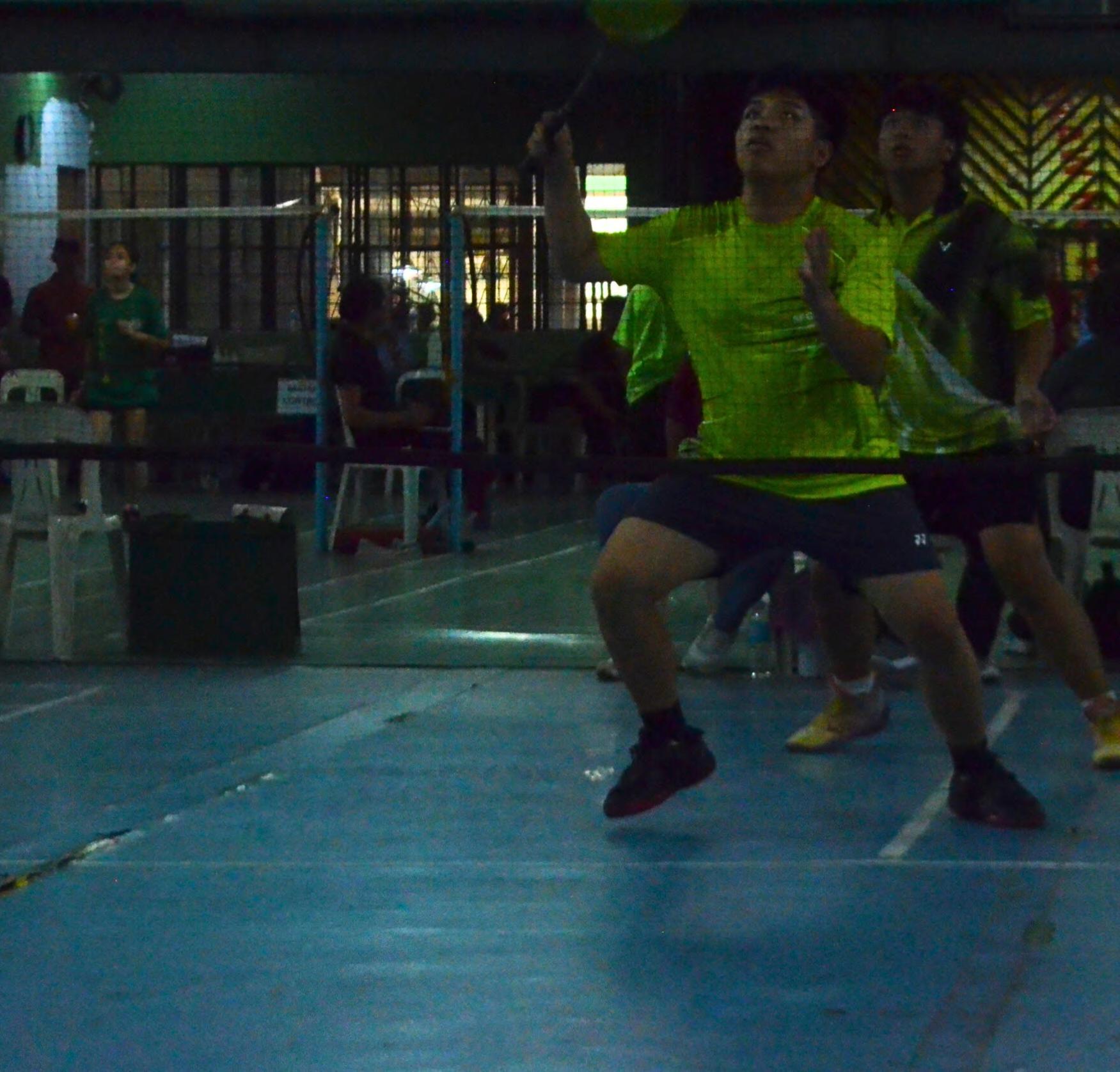
Dantes-Golez made it past Doña Josefa Campus, 21-16, 21-11, and Las Piñas National High School (LPNHS), 21-12, 16-21, 21-11, to qualify for the championship game, where they met University of Perpetual Help System Dalta, suffering a 9-21, 9-21 blowout. On the other hand, Miñoza bypassed the first round of her six-team bracket,
TRADE OF THE SEASON. A photo of Luka Doncic proudly showing his Lakers jersey with his teammates. Photo retrieved from ESPN
By ZACHARY ISAIAH D. SIA
internationalnews.
yet succumbed to Bernardo College in the semifinals, 9-21, 13-21, winning third on a +5 point differential advantage over LPNHS.
Cluster 6, composed of private school delegates, made the championship game in all six categories, winning five. Dantes and Golez were the only delegates from Cluster 3 to reach the championship round.
GRACEFUL GLIDE. Lapiscian figure skater Julia Jean Plata glides gracefully on the ice rink in her dazzling white gemmed dress. Photo retrieved from ICLICK DIGITAL PHOTOGRAPHY
FAST PLAY. LPSci Badminton athletes confidently compete during the 2025 Division Meet.
Photo by AYIN GRACE A. OROZCO

sports. 18 STANDARDPRESS
Leveling the Playing Field LIFTED IN HISTORY
It was a race towards the finish line. Many athletes were striving to run past the fastest one, but no matter how much they tried, they simply could not. There, the best one in the competition stood on the podium, head held high and above the rest. Little did they know that the “so-called” champion was more than two steps ahead of them.
Palarong Pambansa is the country’s premier national sporting event, which many athletes dream of participating in. The event offers a thrilling competition that showcases ability, talent, and passion. Before athletes get to participate in the National Games, they are required to go through several matches and meet certain qualifications, allowing their eligibility to compete. This includes an age limit, requiring secondary athletes to be younger than 18 or the event happening before the athlete’s 18th birthday. However, many schools send athletes who exceed the age limit, putting them at an unfair advantage against their competitors.
Overage athletes have long been present in tournaments, often boasting their experiences and abilities. While they may still be students at their institutions, their participation in events intended for emerging athletes defies what is supposed to be a fair and honest game. Thus, shouldn’t overage athletes be strictly banned from joining these sporting competitions to ensure a level playing field?
According to Las Piñas City National Science High School’s coach Alfredo Santos Jr., officials
verify athletes’ ages by checking their birth certificates. However, some overage athletes manage to bypass this system by forging their documents. This loophole exposes the lack of precision that officials exert in the verification process.
Santos also emphasized the physical advantages older participants have, including more developed features such as strength and height that significantly contribute to a better playing performance. They are also well equipped with experiences they have gained throughout their playing years. As a result, younger athletes struggle to keep up as they face opponents with more advanced abilities and tactics, resulting in immediate losses and unfair games.
Athletes who represent their schools in competitions carry the name and pride of their alma mater, which is why some schools are tempted to send overage participants to ensure victory. Coaches and athletes then overlook ethics as they are tempted by the rewards that joining the Palarong Pambansa offers. This includes benefits such as generous allowances from local governments and the opportunity
to travel and pursue their passion without worrying about expenses. With these incentives, it is easy to see how temptation overpowers morality. Violating rules removes the true essence of competition. Winning should always come from a fair contest where the playing field is leveled for all. No one should be placed at a disadvantage just because their opponents are both physically and mentally more capable from years of accumulated experience. Unequal play also removes the thrill of games as results may be predictable, with younger athletes having no chance to leverage their experiences or even win.
On a playing field where integrity is lost, coaches and athletes must strive to value ethics over being blinded by unjust wins. They must abide by the rules and honor the reason why competitions, such as Palarong Pambansa, are held in the first place. A stricter implementation of the age limit and an improved verification system should be the first step that sporting officials prioritize to ensure equal opportunities. After all, it is the youth that take a step back when injustices take two steps forward.

On a playing field where integrity is lost, coaches and athletes must strive to value ethics over being blinded by unjust wins.
“ ”
Hidilyn Diaz Ingrained in PSA Hall of Fame
By GAVIN MIGUEL R. DY
Athousand miles away from home, yet all eyes were on her. Every weight she had conquered up to this point couldn’t compare to the one that laid in front of her. It wasn’t just 127 kilograms on those plates, but the weight of the nation’s hopes and dreams rested upon her shoulders. This wasn’t an unfamiliar sight for Hidilyn Diaz. She had seen the biggest stages the world had to offer and had been so close to the golden road, but it always seemed out of reach. As she stepped forward to lift the final barbell, little did she know that history was in the making.
Four years later, Hidilyn Diaz was forever etched in history with her legacy now engraved in the Philippine Sportswriters Association (PSA) Hall of Fame—the first-ever Filipino athlete to bring home an Olympic gold medal.
Hidilyn Diaz, once a little girl who used to train with makeshift barbels at the age of nine, is now an icon in Philippine sports history, having been enshrined in the Hall of Fame during the San Miguel Corporation-PSA Awards Night at the Manila Hotel on January 27.

againstallodds.
IThe 33-year-old is the latest athlete to be inducted into the Hall of Fame since the late Lydia De Vega in 2022, who was dubbed the fastest woman in Asia in the 1980s. With Diaz’s addition to the “Hall”, she became the youngest member among Filipino sports legends such as Manny Pacquiao (boxing), Efren “Bata” Reyes (billiards), and bowlers Paeng Nepomuceno and Bong Coo.
Hidilyn’s impact on the Philippine sports scene, brought about by her success in the 2020 Tokyo Olympics and other international competitions, is evident in the person whom she shared center stage at the event—Carlos Yulo, who recently won double gold medals in the men’s floor exercise and vault at the Paris Olympics.
“She showed me the medal, and I told myself, next time, it would be me. Ako rin, kaya ko rin, next time,” said Yulo after his victory at the Paris Olympics. The Golden Boy consistently praised Diaz, who had inspired him to aim high and dream big—motivating him as he eventually became the

Love for the Love of the Game
By LANCE KIANE G. SALUDO
n her rookie season, Caitlin Clark, women’s college basketball champion, all-time leading scorer, and #1 overall pick, is now the undeniable face of the WNBA, just as we expected. Already a 1x All-Star, the female phenom has shattered multiple league records, on and off the court. Naming some of them: she already holds the assists record in a game, is the first rookie to put up a triple-double, and has broken viewership and attendance records not only for the Indiana Fever but also the whole rest of the league. Her debut reached 2.1M views, finally competing with NBA Opening Night (2.7M). Caitlin has transcended the game and culture of women’s basketball, which was once a hopeless sport. With all of this, she should
deserve all the brand deals, fan attention, and accolades, right? If such is the case, no logical reason should justify any pushback on all this spotlight and success. Not only can she do things to a degree nobody else can, but she also saved 155 other players from a failing league. It would be justifiable if some fans doubted the longevity of her current skillset. But instead, the distinct people who are robbing Caitlin of her due flowers are her own peers, those who should’ve been the ones fostering and uplifting her all along as the face of the women’s sport.
Then NCAA, now WNBA rivals Caitlin and Angel Reese have transformed into not just an on-court feuding but also one fueled by onesided jealousy from Reese. Angel, I can assure
you that the switch to bigger arenas during Fever games, the jersey sale statistics, and the threepoint records are not all a coincidence. People are watching the WNBA because of Caitlin Clark, and the people are watching her because she has skill in the sport no other woman can replicate.
To A’ja Wilson: you might have deserved that $28 million Nike deal winning multiple league MVPs already, but your race-justified outrage doesn’t make it the most valid of arguments.
The NBA needed Magic Johnson, the MLB needed Babe Ruth, the UFC needed Conor McGregor, and now, the WNBA needs Caitlin Clark. All these leagues were good in their own right before these notable players, and the presence of league-transcendent talent doesn’t
devalue or steer away credit from everyone else. In fact, these players are the catalysts to making everyone else more visible too.
Caitlin may not be the star who engages with external discourse, may not be one who is politically vocal, may not be LGBTQ+, and may not be Black, Hispanic, or Asian, but she shouldn’t deserve any scrutiny for her achievements that do not derive from these traits of hers.
Caitlin has said over and over and over again that basketball is her main focus, and that’s okay! After all, that’s her craft, that’s how she helps the league grow, and that’s her personal right. We cannot choose who becomes our superstars — only those who are gifted god-given skill and know how to foster it can.
A HEAVY LIFT Olympic gold
medalist Hidilyn Diaz successfully lifting her weight during the clean and jerk of the 2020 Olympics. Photo retrieved from ONE SPORTS PH



Height Of Success
eople say that obsession beats talent.
A driving force that pushes athletes to continually master their skills and perfect their craft in their chosen sport is far greater than any natural gift that makes one an instant star. Overcoming every setback with the mindset of growth makes athletes unstoppable, showing that obsession may actually be one of the best traits they can possess. However, where does success lie when athletes obsess over a sport that is impossible for them to excel in?
We, Filipinos, are aware of the popularity of basketball in the country. Highly influenced by the Americans, this sport is loved by people of all ages. Seeing people playing on the street or in a court, be it early morning or late at night, is a typical scene, with each dribble, pass, and shoot symbolizing the hope of being successful with a basketball career. Little do they know that they have only been successful in giving themselves false hope as qualifying in major competitions, both locally and internationally, is far from possible.
Basketball is a sport that requires height, but we Filipinos typically lack the necessary stature, as the average Filipino man is 5’4” tall. Hoops ranging 10 feet in height are difficult for Filipinos to reach, and it would take extra effort for them to match the performance of Westerners who boast greater heights. Running and dribbling require speed and control, and a player who stands at over six feet will definitely have the edge in covering a greater area to reach the other side of the court. Defenses are also easier when one has strength to block opponents and jump high enough to prevent basketballs from entering the ring.
One might ask: Is it possible for the Philippines to excel in basketball? Yes, it definitely is as the country was able to log its golden years from five consecutive appearances from the 1936 Berlin Olympics to the 1960 Summer Games in Rome. However, the real question lies in whether it is actually still practical or just an obsession among athletes. It has been over five decades since the national team had qualified for the game, with the 1972 Munich Olympics as their last rodeo. Despite modern efforts like Gilas Pilipinas, success on the world stage has remained limited. Gilas ended their 2024 Paris Olympics campaign with a 6071 loss against Brazil, symbolizing that no matter how much time they had to prepare, obsession does not always translate to victory. Coming close to a podium finish simply did not seem like an option for them anymore.
Obsession has overpowered practicality. Dreaming big never hurts, but athletes must never dream impossible dreams. This is a call to them to dream of success in a stadium fueled by obsession for a sport that will be there to benefit them in return—for a shot at hope and a shot at success.

MIRACLE RUN ENDS
PH
falls to TH in first football semifinals after 6 years
For the first time since 2018, the Philippine Men’s National Football Team (PMNFT) made a semifinals run in the 2024 ASEAN Mitsubishi Electric Cup, where they eventually lost to Thailand, 1-3, in extra time at the Rajamangala Stadium in Bangkok on December 30.
This defeat came after a remarkable performance in their first semifinal matchup, where they secured a historic 2-1 victory over the defending champions, ending a 52-year winless streak against the War Elephants in the first leg of the semifinals held at Rizal Memorial Stadium on December 27.
Despite the Filipinos’ impressive outing, Thailand narrowly advanced to the
finals in their second meeting, gaining a 4-3 aggregate score late in the game, thanks to last-minute heroics by substitute Suphanat Mueanta, who scored the gamewinning header in the 116th minute. Kickoff for the Finals
The Philippines got off to a slow start in the second leg, which the War Elephants took full advantage of as they scored two goals in under an hour of play to make the aggregate score 3-2 in favor of the Thais.
When all hope seemed lost for the Filipino squad, Bjorn Martin Kristensen came on in the 73rd minute and kept their hopes of reaching the finals alive with a goal in the 84th minute which forced the game into extra time.
“It felt really good, because it was like, wow, we’re in Thailand, in front of 30,000, in a semifinal, and they’re the
ones who are defending. We’re the ones with the ball. That felt really good,” said Sandro Reyes, the national team’s midfielder.
Hope for Philippine Soccer


Although the PMNFT eventually lost in extra time, Philippine head coach Albert Capellas was happy with the team’s performance after defeating regional powerhouses like Indonesia, Thailand, and Vietnam earlier in the tournament.
“We just arrived at this level.
For a lot of years, we couldn’t play these types of games — to fight until the last second against Thailand, Indonesia, and Vietnam. It’s the first time we are here
a lot of



Somewhere along the streets of Diliman, at the home of the Oblation, they are proving that they don’t only possess intellect–they can also showcase their talents in the field of sports.
A team that once struggled against the top competition has overcome the odds and is now an undeniable force in the University Athletic Association in the Philippines (UAAP).
The University of the Philippines’ (UP) Fighting Maroons basketball team is once again at the top of the UAAP, grabbing their second championship in just a span of two years. You may think that their current series of victories came easy to them, but here’s the thing: success is earned, not given.
Prior to their victory in the 84th season in UAAP, the Fighting Maroons were in an agonizing 36-year championship drought. Looking at their
current state, it is a completely different story now. With momentum now on their side, they capitalized on the opportunity and asserted themselves as one of the top powerhouses in the league. With all this success, you may ask–how did they manage to accomplish this?
UP’s program has been its ability to recruit top prospects and develop young aspiring talents, JD Cagulangan and Quentin Millora-Brown, to name a few. People were skeptical about how a public university with declining resources could attract these athletes, but their approach goes beyond financial incentives.
look at the UAAP games,
UP’s thunderous crowd always stands out above the rest. The power of UP’s community is what sets them apart–it shows their passion and loyalty,

championship. This shows the value of community and how it helps inspire the athletes.
Their culture of winning would not be accomplished without the absolute dedication of the Maroons. UP’s support system amplifies their energy and ability to perform at the biggest stages and the highest level. This has led them to victories, like the most recent UAAP men’s basketball championship. These will be forever cemented into the history books.
The Fighting Maroons’ rise in the UAAP is a testament to their relentless strength and fighting spirit. Their winning culture is living proof of hardearned work and perseverance. Through adversity and obstacles, they have redefined what it means to be a champion and have highlighted the importance of culture and support from fans. This story shows that the fruits of success are based on the effort you put into your work. UP Fight!
after
years,” Capellas said. The group will return to the pitch to compete in the third round of the 2027 AFC Saudi Arabia Asian Cup Qualifiers where they will face Maldives for their first match of the tournament on March 25.
By GAVIN MIGUEL R. DY
By ZACHARY ISAIAH D. SIA
Art by MARYCAR MITZI O. CRISTOBAL
UP FIGHT. A photo of the Fighting Maroons celebrating their win after grabbing the top spot of the UAAP season. Photo retrieved from UAAP SEASON 87 MEDIA TEAM
By DIANE SARAH V. BARRETTO wingsofglory.
OLÉ OLÉ OLÉ. The PMNFT gives their all against Thailand at the semifinals of the 2024 ASEAN Mitsubishi Electric Cup in Bangkok, Thailand at the Rajamangala Stadium on Monday, December 30, 2024.
Photo from PHILIPPINE FOOTBALL ASSOCIATION
Photo from UP DILIMAN


STANDARDPRESS
PARAGON OF TRUTH AND FREEDOM
Dancesport was first introduced as a demonstration sport in the 2017 Palarong Pambansa. After several years, it is now officially elevated to a regular sport in the 2024 Palarong Pambansa.

Grace, Pace, and AWinningPlace
By CYREE ELISHA B. PAMPLONA
The recent feats in the 2025 Division Meet Dancesport Competition further proved the pure talents and relentless training of the Las Piñas City National Science High School (LPSci) Dancesport Team, Lapiscian Modern Standard dance athletes Arvin Josef Lyon Padilla and Sophia Ysabelle Estrada, cornered the top spot to secured a ticket to the NCR regional meet.
Unexpected Beginnings
For Padilla, a Grade 12 student, his foray into dancesport had been an accident in Grade 10. Looking back to his unexpected start, “I really didn’t expect myself to be in this court at all, and I’m just here because [when I was in] Grade 10, I tried something new,” he shared. He challenges his peers to take

heed of the simple message of “Just try something new, and you never know, you might love it.”
Behind the Spotlight
Their excellent performances are the result of their rigorous training system. Competitive ballroom dancers, like Padilla and Estrada usually attend three to five practice sessions in a week. This may involve performance rehearsals, solo practice sessions, and group classes with their fellow dancesport athletes. A week in the life of a dancer can be made up of two to three lessons with their partner, four to five individual practice sessions, and one to two group classes while balancing schoolwork.
Of these, physical conditioning is essential. It may include other cardiovascular activities which fortify endurance and stamina. Building strength through training involves squats, lunges, planks, and push-ups; this is where one needs
muscle strength to perform most dancesport routines.
It involves much core strength, which will give the stability and control that might be required during some pretty intricate routines. Dancers also perform other exercises for core muscles, like crunches, side bridges, and leg raises, to help them execute figures, steps, routines, and techniques precisely and elegantly.
The mental aspect of training is just as important. All the discipline, persistence, and resilience developed through the rigorous practice sessions prepare the dancers to be able to perform under the glaring lights, with judges’ eyes scrutinizing every movement and the electrifying energy of the crowd–all amidst the dynamics of competition.
Coach’s Words
Coach Peter Daniel Bangug acknowledges the team’s progress: “Not perfect, but it has already
improved. Hindi ko masasabing wala silang mali pero ito yung pinapanood natin na dancesport talaga.” Looking ahead of the NCR meet, he emphasizes the need for intensified preparation. “Going to NCR, maybe we’re going to take a short break. [February] is the NCR meet month, so they’re gonna be training a lot,” he added.
Padilla and Estrada’s success underlines the impact brought about by dedication and hard work. Their achievements are an inspiration that shows the possibility of excellence in dancesport with passion and perseverance.
As the LPSci Dancesport Team prepares to compete in the NCR regional meet, there is no slacking in their commitment to rigorous training and continuous improvement. The LPSci community anticipates more dynamic performances from them, as their hard work shall continue to shine through the dance floor.
what’sinside?




Doncic to Lakers, Davis to Mavs in historic superstar trade
news.
